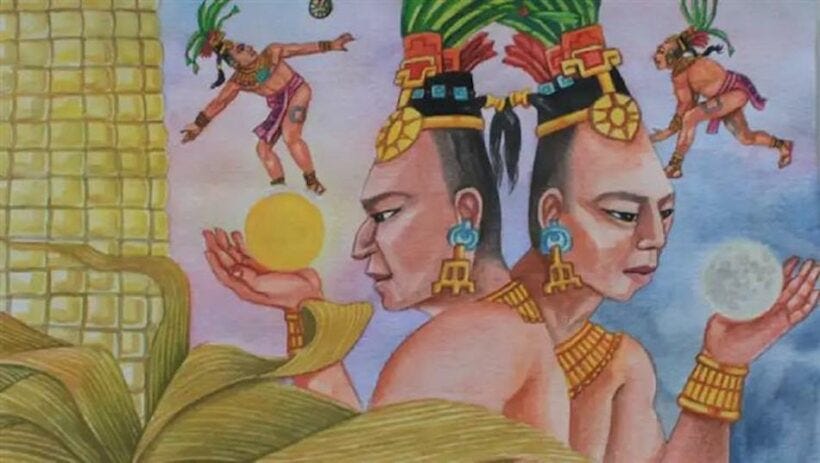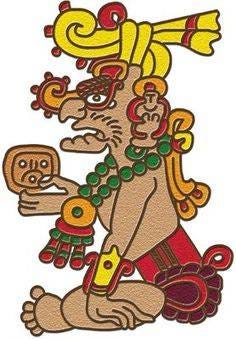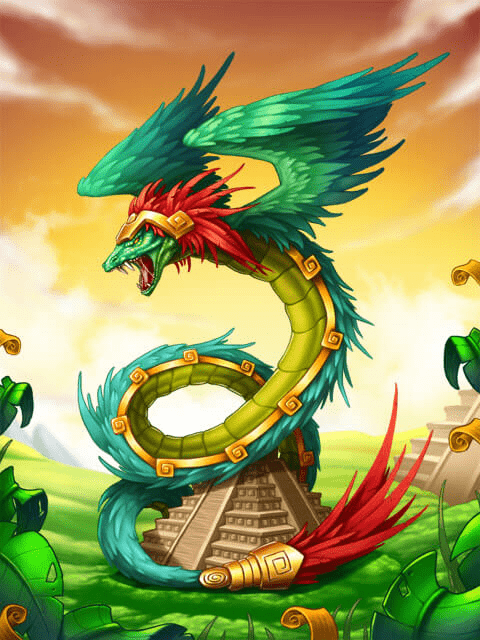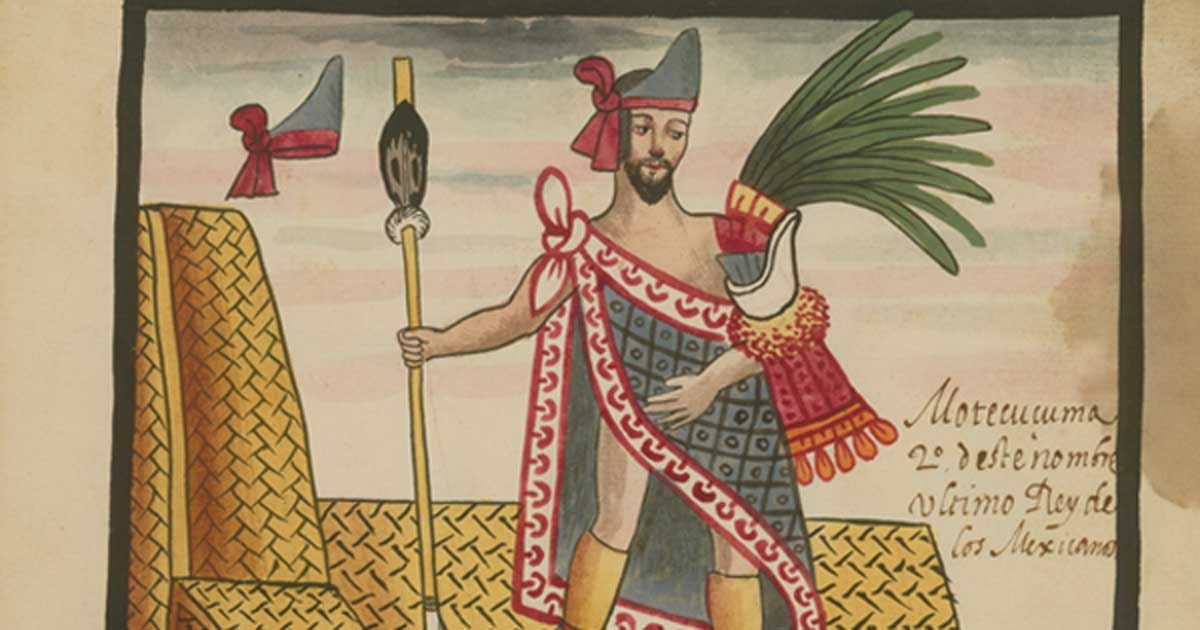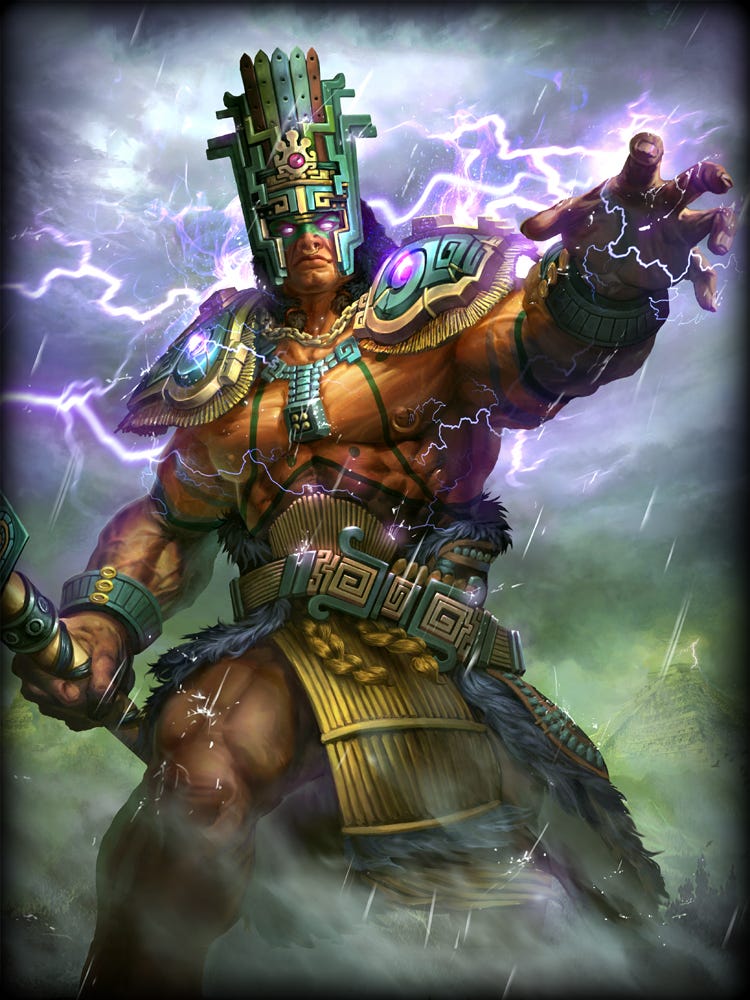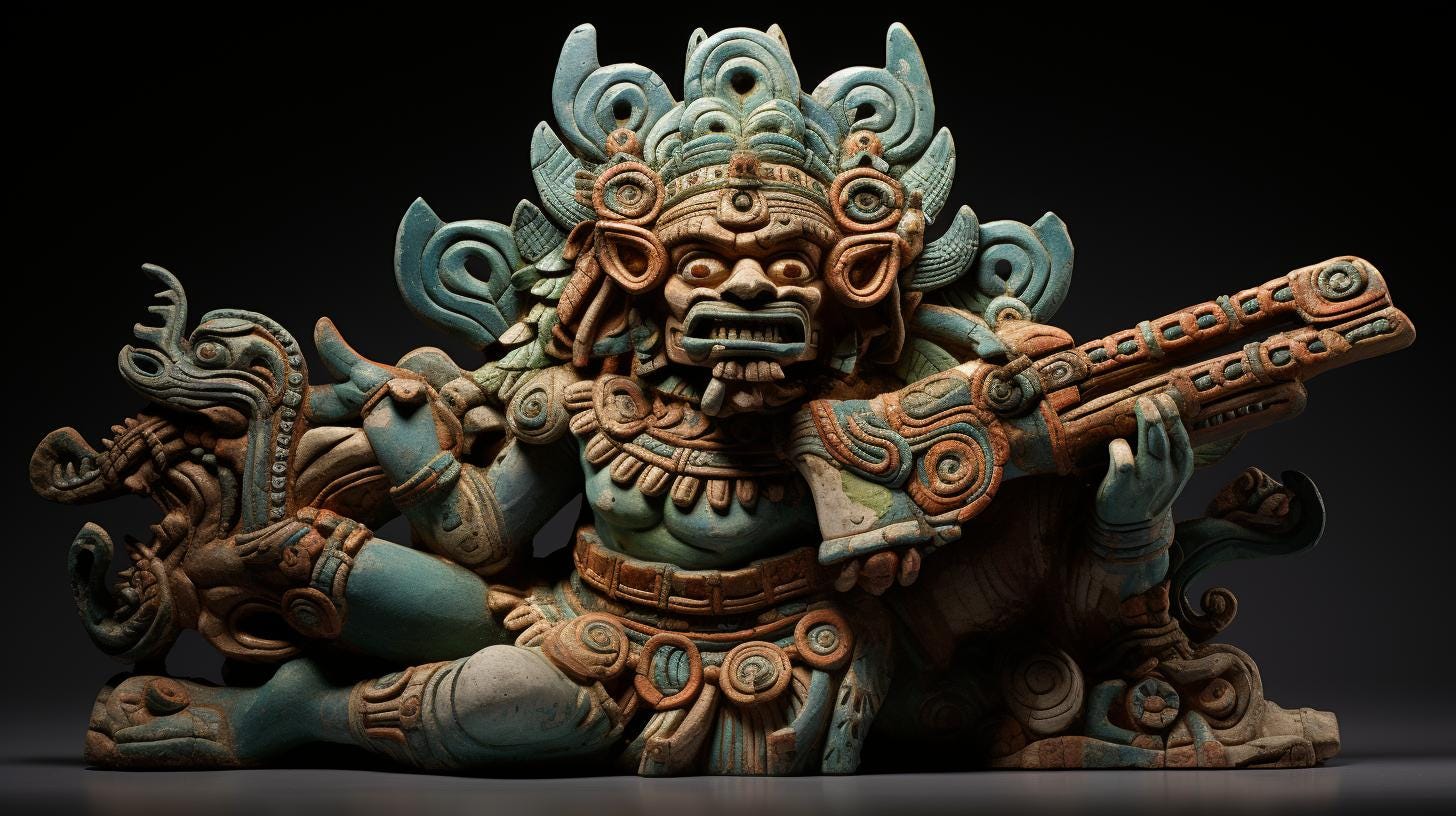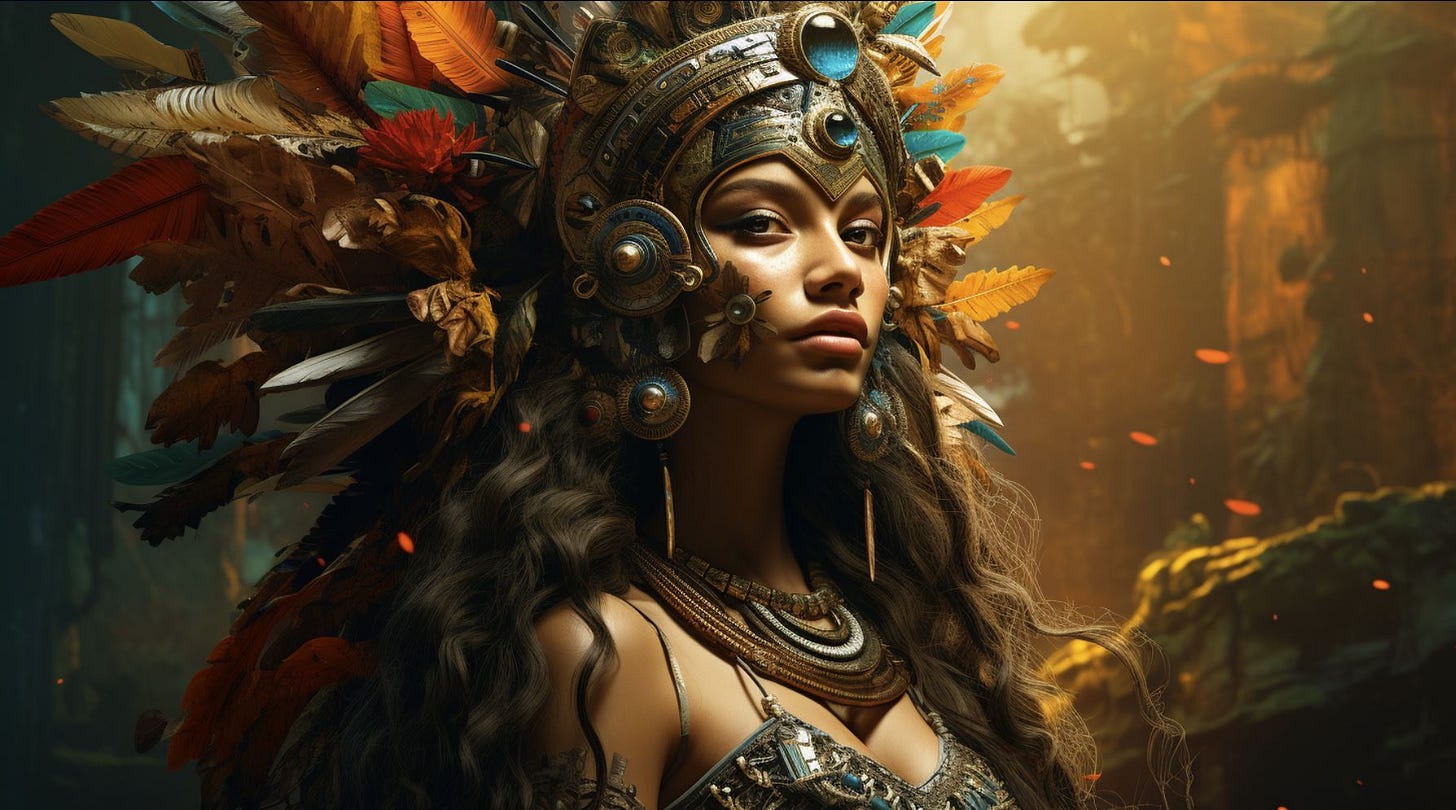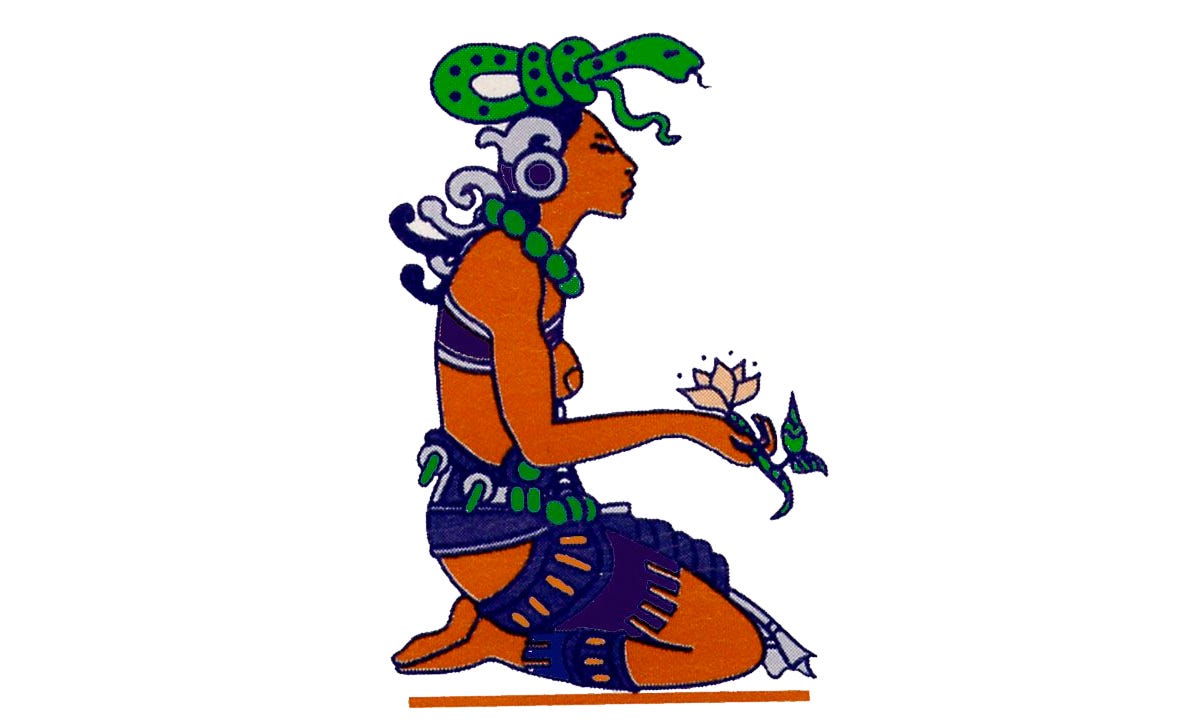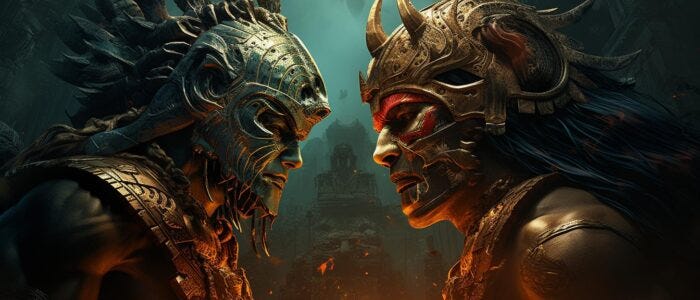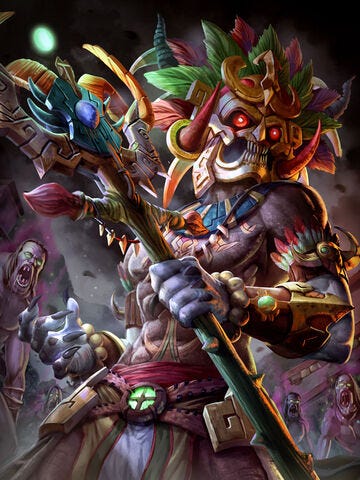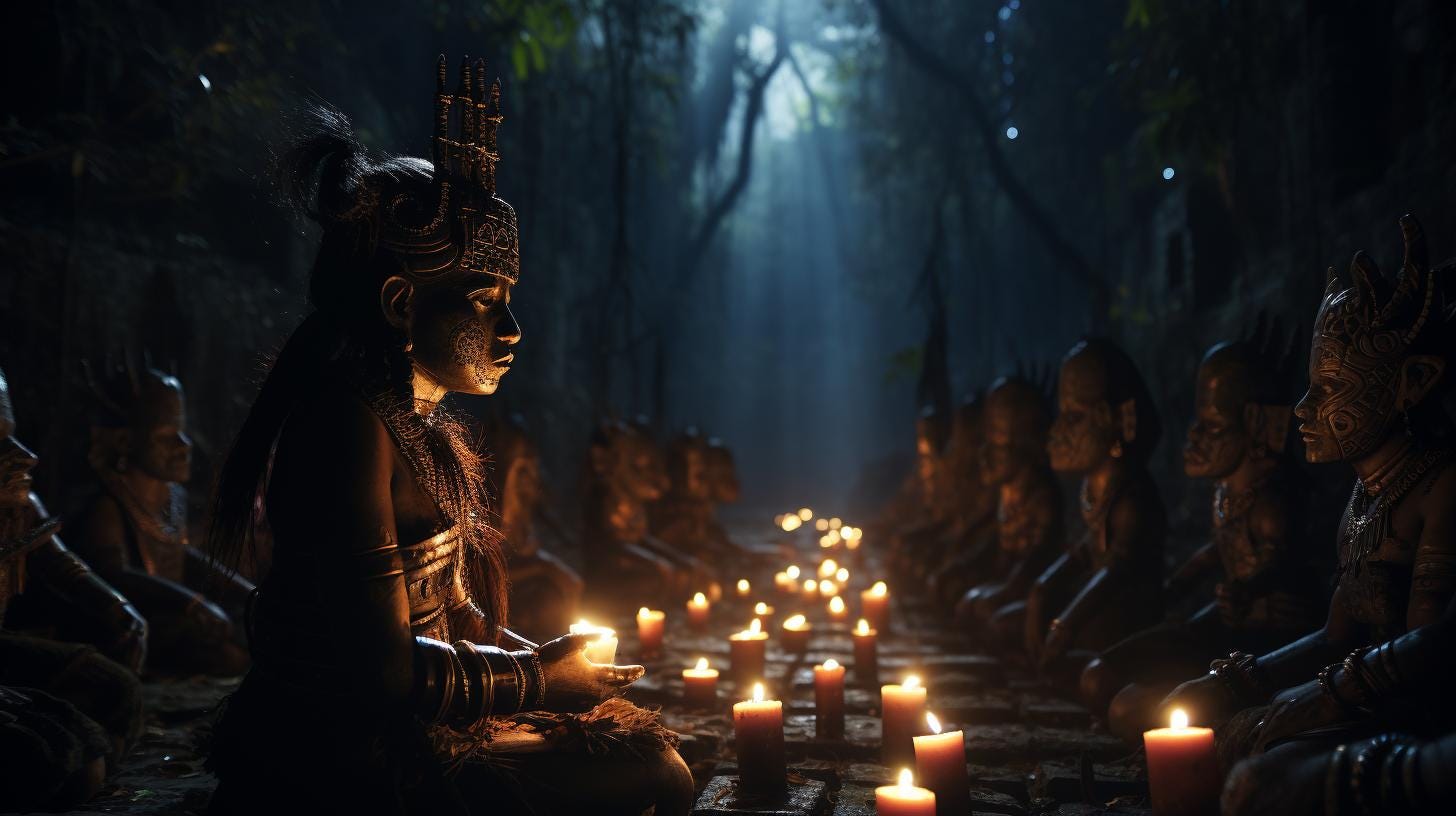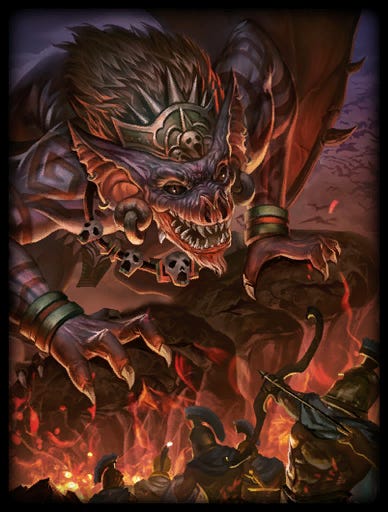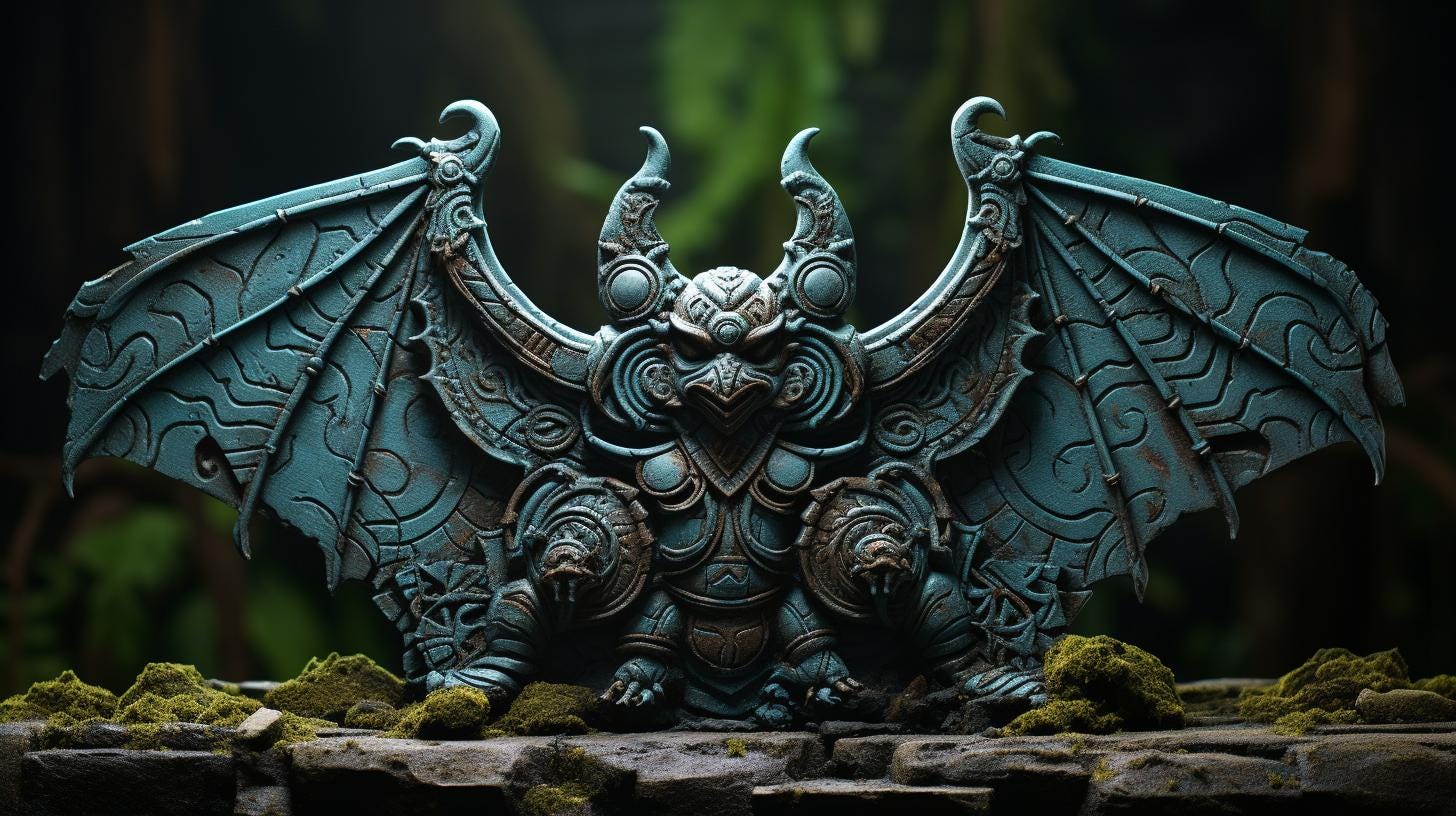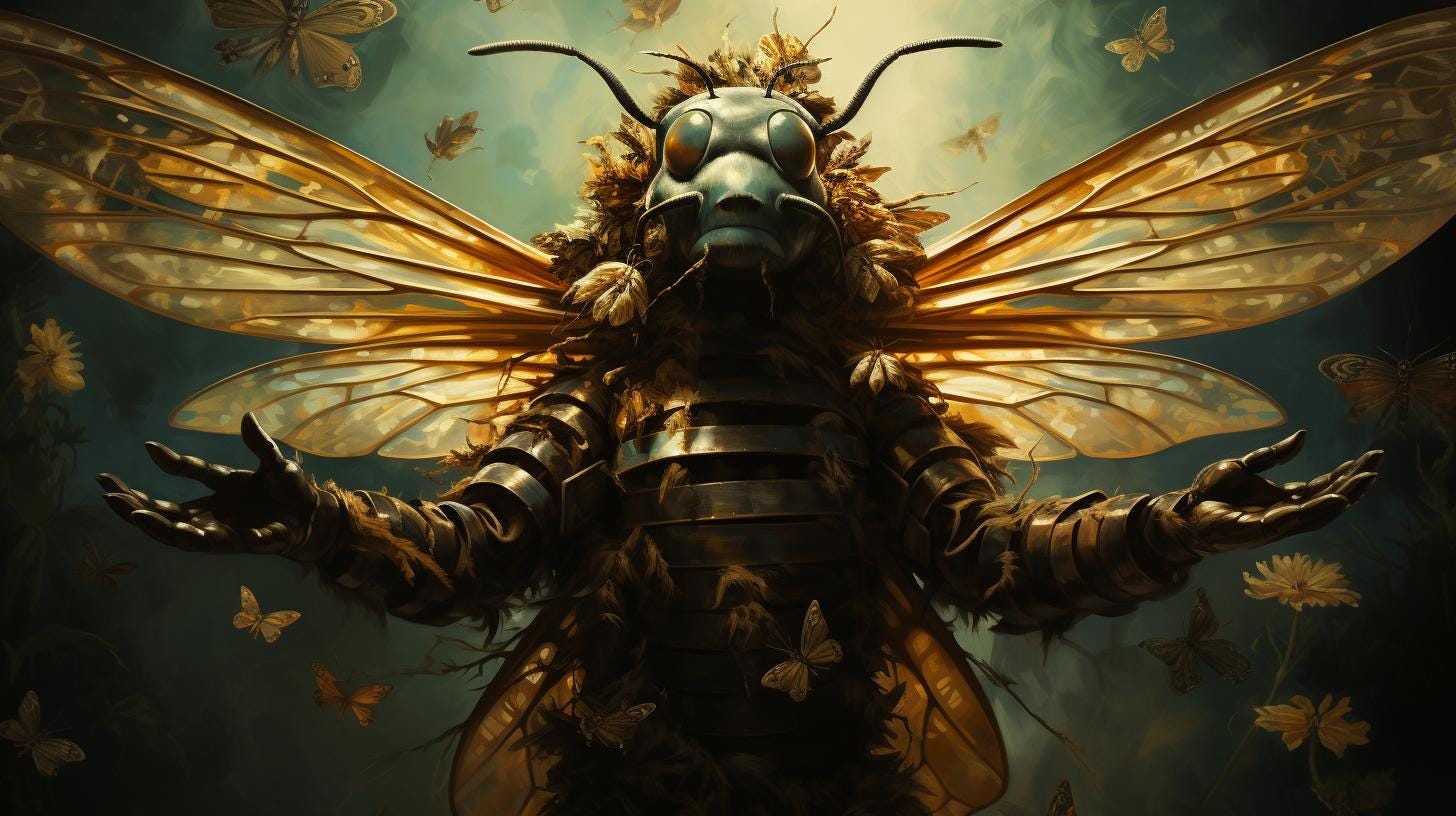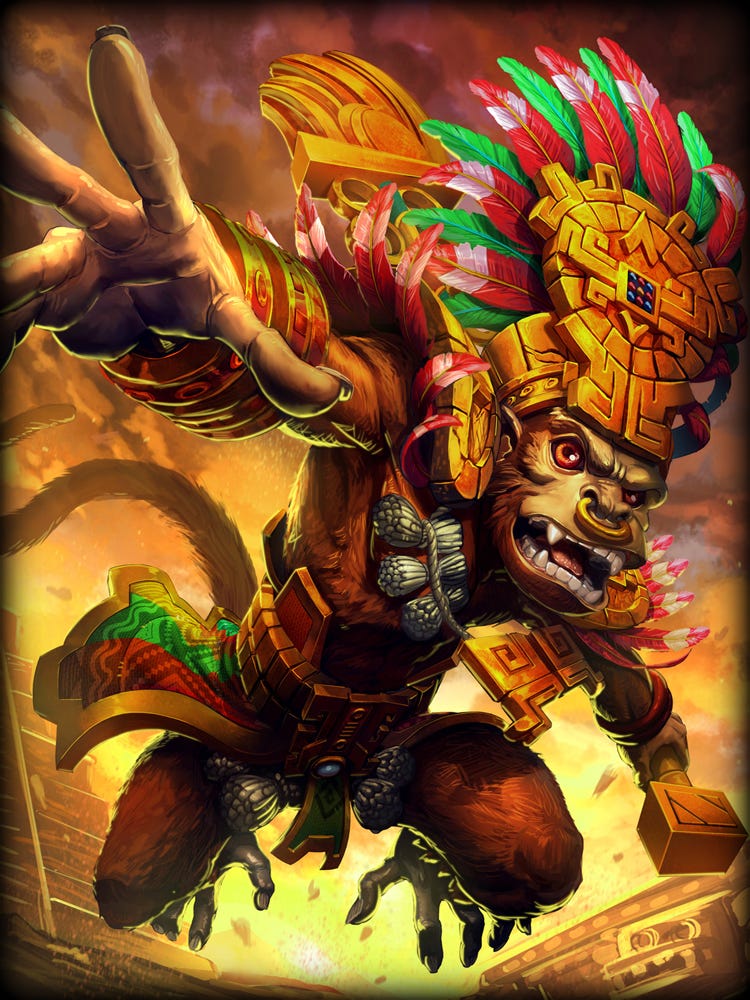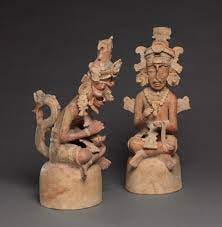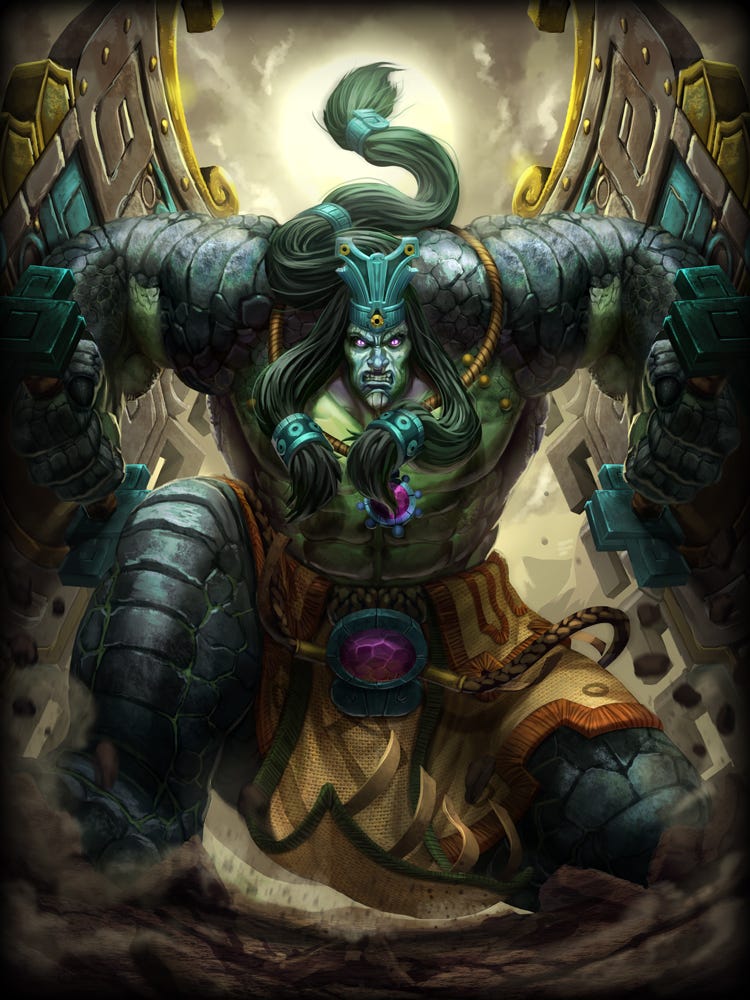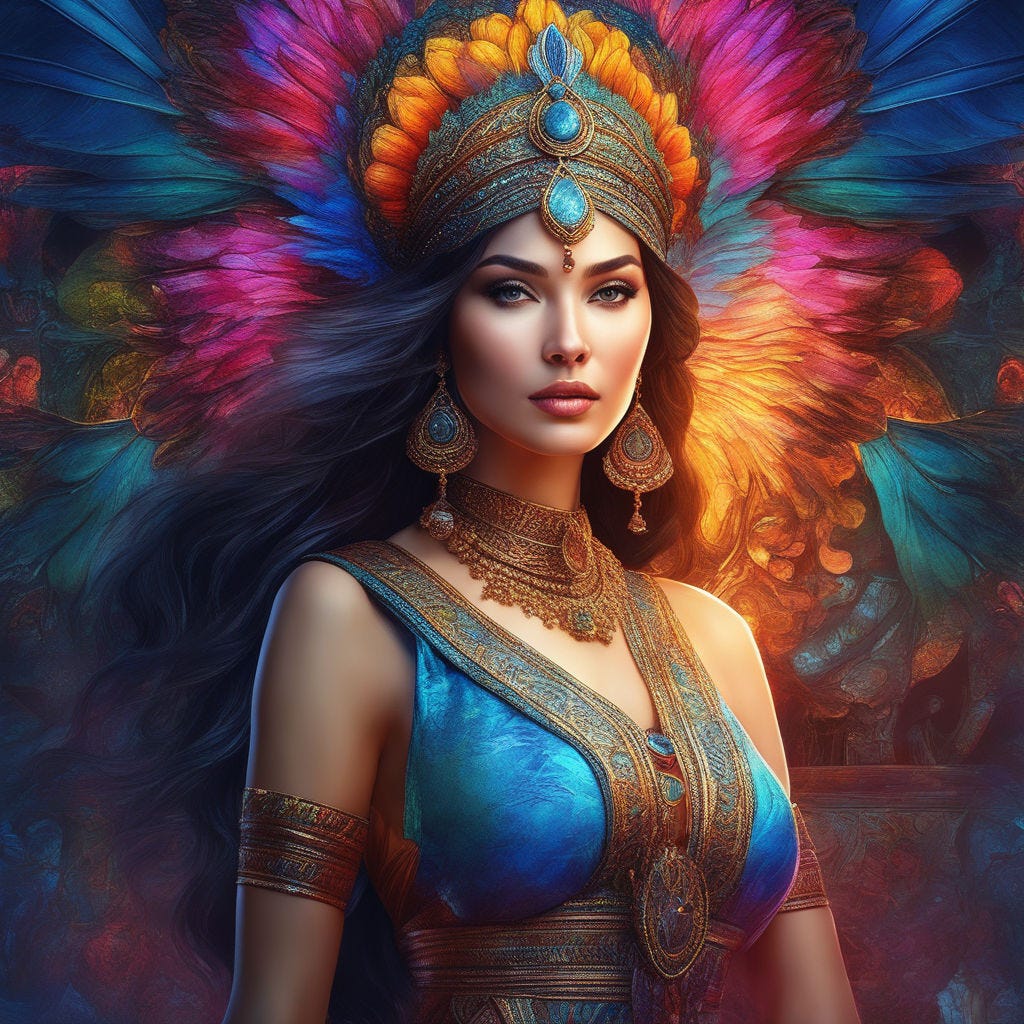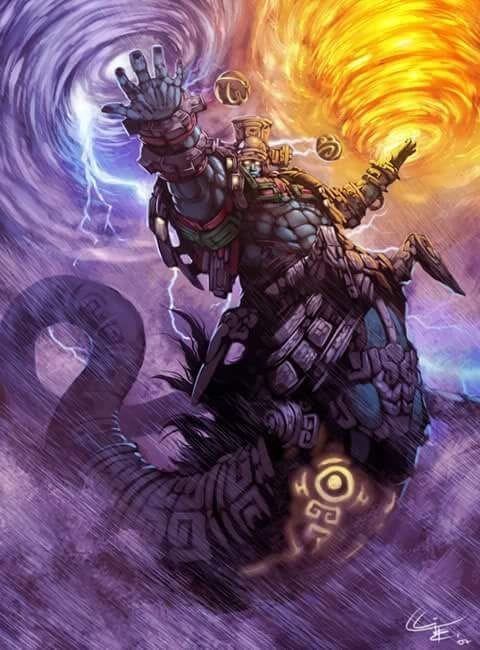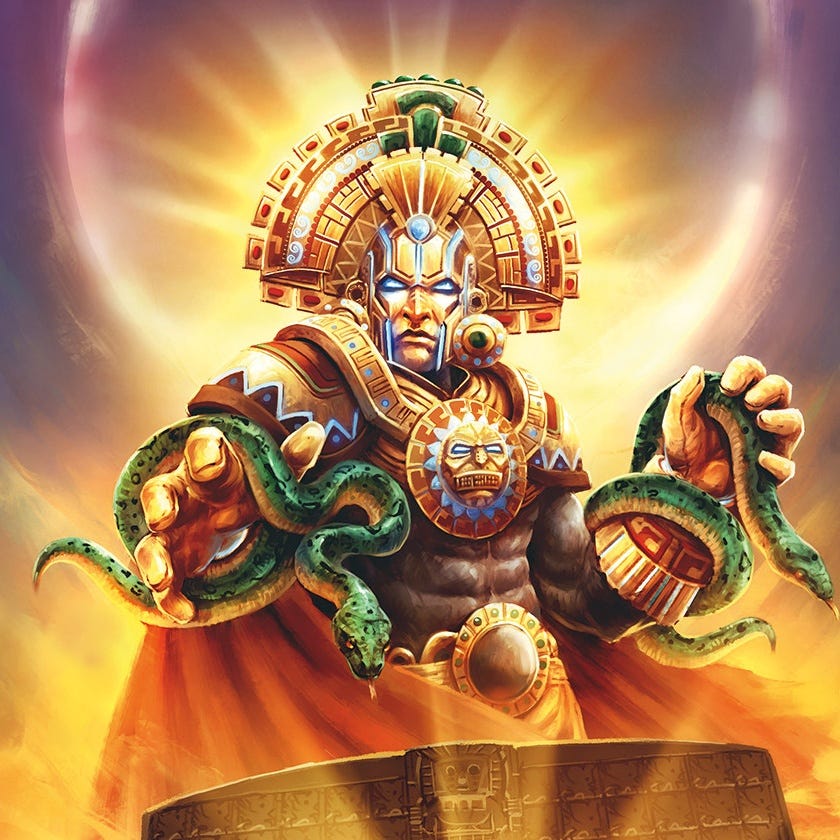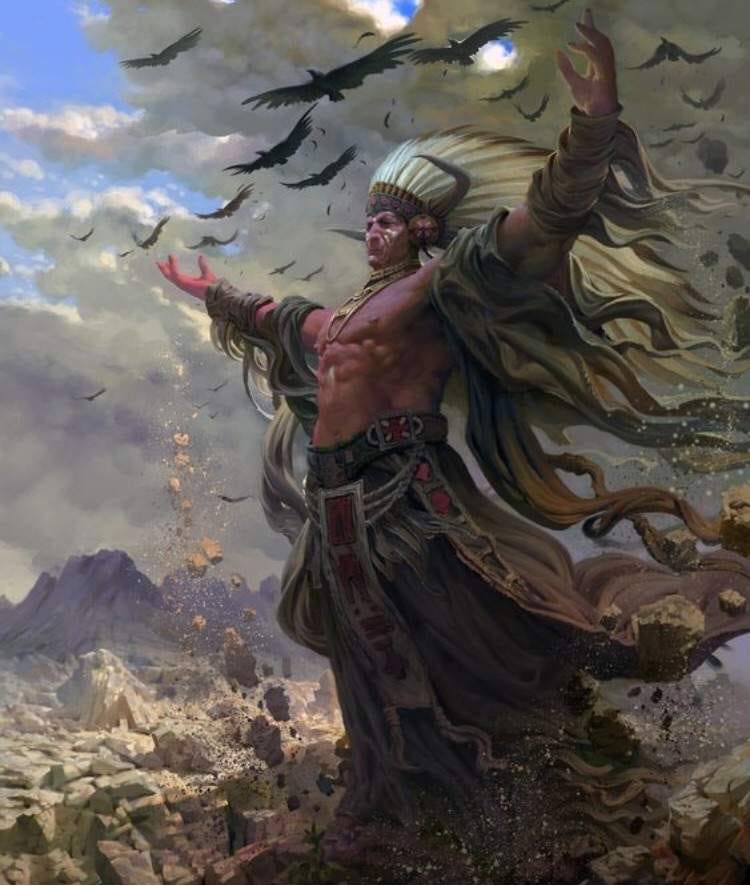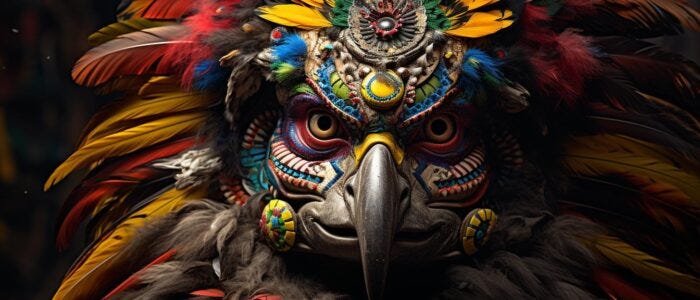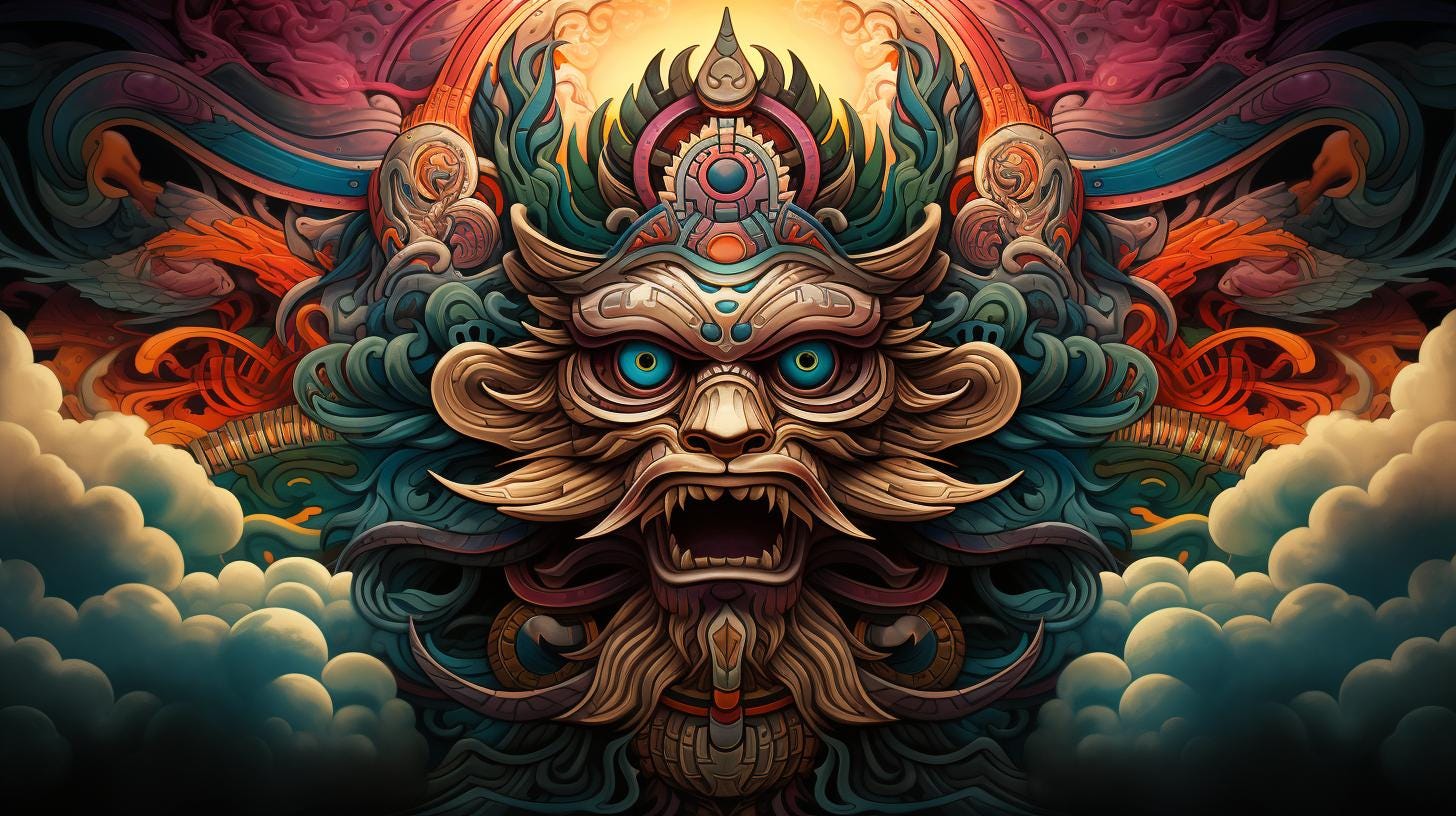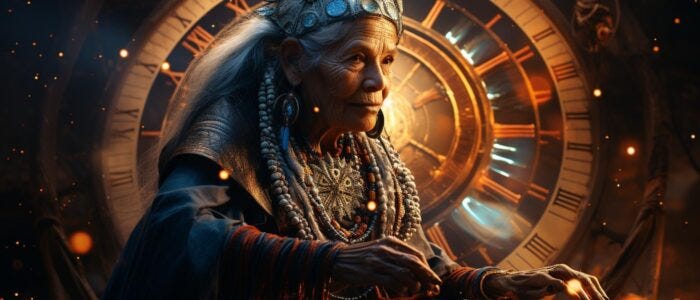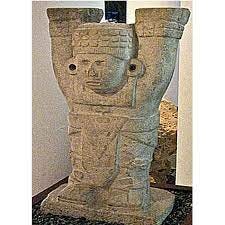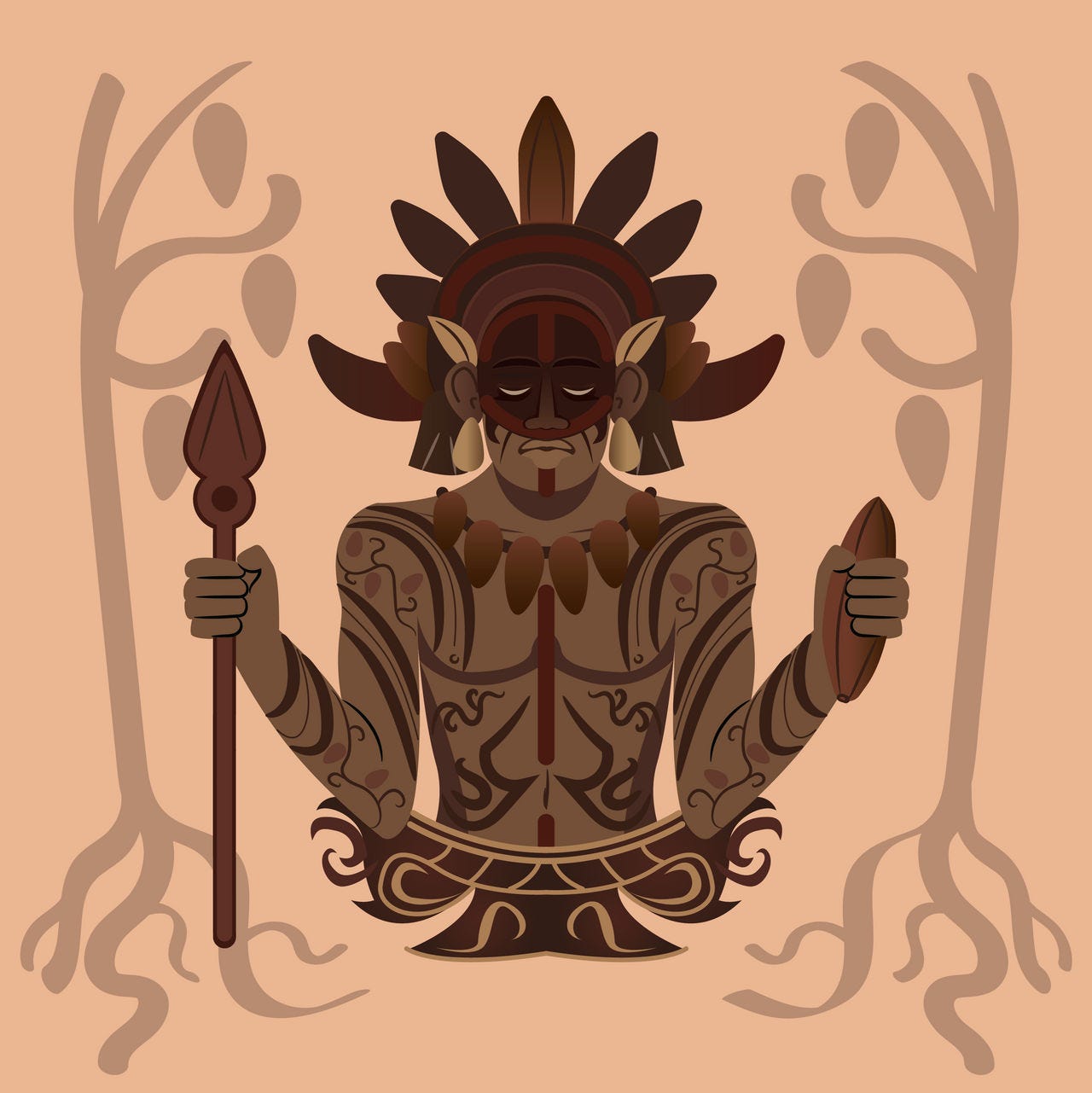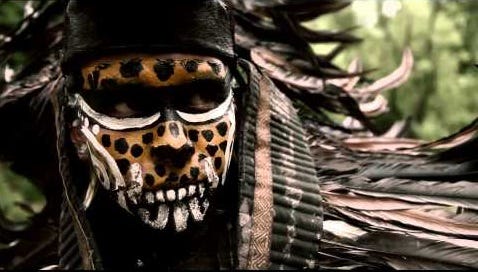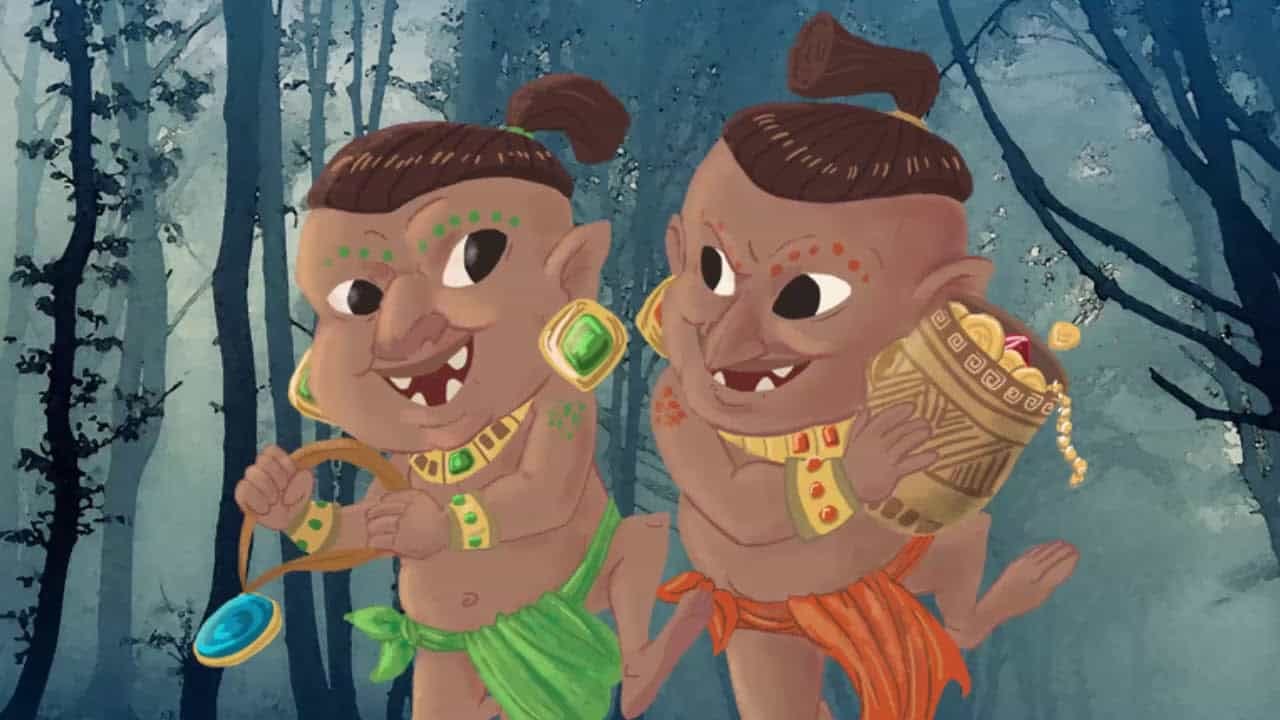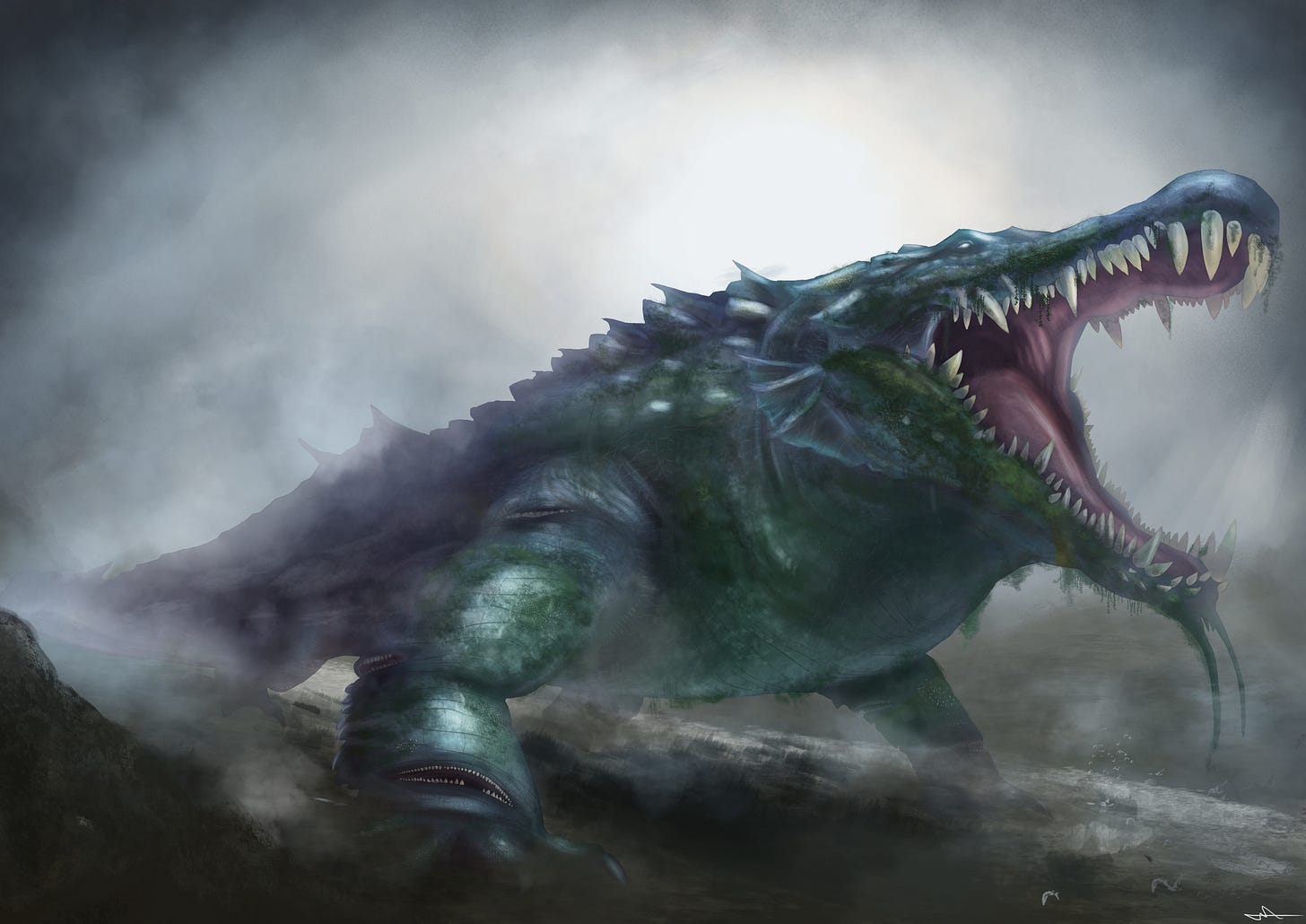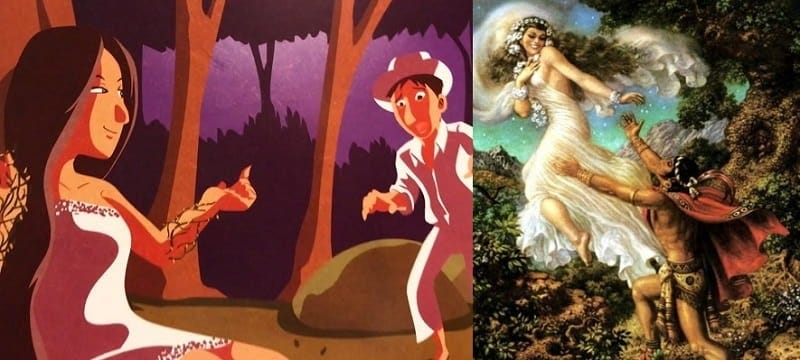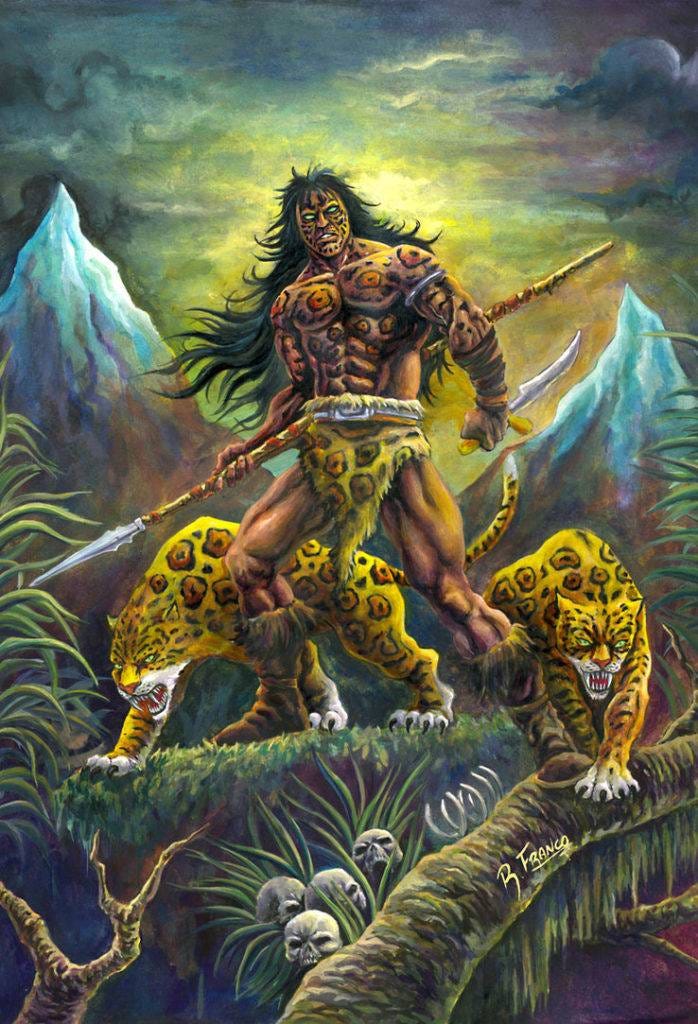1.) The Popol Vuh: Creation Story
Discovery and Translation
The stela at Quirigua, a Classic Maya site, depicts a story from the Popol Vuh, indicating that three stones were placed in the sky at the beginning of Maya creation. This connection between the Popol Vuh and the start of Maya time highlights the significance of understanding the Popol Vuh to gain insights into the identity of the ancient Maya.
Francisco Ximénez was a Spanish Dominican friar who translated and preserved the "Popol Vuh," an important Maya text. He discovered it in Guatemala, translated it into Spanish between 1701 and 1703, and included it in the "Manuscript of Chichicastenango." Ximénez's work is significant for preserving Maya culture and history, though there has been debate about potential Christian influence in his translation.
The First 3 Creations
The Mayan Creation Myth begins with a primordial state where there was nothing but endless sky above a primordial sea. In this empty expanse, a group of gods sought to create the Earth. These gods are often referred to as the Maker and the Modeler or the Bearer and the Begetter. Together, they were tasked with shaping the Earth. Their initial attempt resulted in the creation of animals, followed by humans made from mud. However, these early creations were imperfect and were washed away by rains.
The gods made several more attempts, creating humans from wood and other materials, but none of these creations were satisfactory. The world remained in darkness, and the sun had yet to rise. Furthermore, none of these creations could speak to honor the gods properly.
7 Macaw and the Hero Twins
7 Macaw was a giant bird with jeweled eyes, shining beak and feathers like gold and silver. He climbed up a huge tree and said he was the sun and the moon as he wanted to be viewed as a God.
The Hero Twins, Hunahpu and Xbalanque, aimed to defeat 7 Macaw, but he tore off Xbalanque's arm, which is depicted on Izapa Stela 25, an over 2,000-year-old artifact. They sought help from their grandparents and devised a scheme to trick 7 Macaw into losing his teeth for corn kernels and then his eyes, leading to his defeat and death. This story serves as a cautionary tale against excessive pride. In the Maya ruins at Caracol, there are bird masks, one with shiny teeth and the other with teeth resembling corn kernels, reminiscent of 7 Macaw's downfall.
Father’s Story
In the Popol Vuh, we learn about the origins of the Hero Twins and their divine fathers, 1 Hunahpu and 7 Hunahpu, who were gods and avid ball game players. The Hero Twins had older brothers, 1 Batz and 1 Chouen, forming two pairs of twins who played the ball game tirelessly. However, the noise from their games disturbed the Lords of Death, who resided beneath them. They challenged the Fathers to a ball game in the underworld and the Father’s failed the trials and were sacrificed and killed.
Transformation of the Older Twins
In the Popol Vuh, 1 Hunahpu's head (one of the fathers that was killed) was hung in a calabash tree, and it was forbidden for anyone to pick the fruit from that tree. Lady Blood, one of the lords' of the underworlds’ daughters, became curious and reached out to pick the fruit, but the head in the tree spat in her hand.
Lady Blood then gave birth to Hunahpu and Xbalanque, the Hero Twins, after being impregnated by the head. The older twins, 1 Batz and 1 Chouen, who were gods, put the younger boys through trials, but the children remained unharmed. Eventually, the younger twins tricked the older ones by turning them into monkeys while hunting for birds, a transformation that is still mentioned in modern Maya lore.
Hunahpu and Xbalanque in the Underworld
Hunahpu and Xbalanque attempted to become corn farmers but failed as the plants they chopped down at night magically grew back. A talking rat informed them that they were destined to be ball players like their fathers. The rat showed them where their equipment was hidden in the roof of their house, which is depicted in Maya ruins like the stucco at the site of Tonina showing a rat lowering down a ball.
Their success as ball players led to loud stomping, which reached the ears of the Lords of Death in Xibalba. The Lords sent a messenger owl to summon the twins. Hunahpu and Xbalanque followed their fathers' path to the crossroads, choosing the black road. The Lords of Death tested them with trials, and this time, the twins succeeded. They were then challenged to a ball game, which ended in a tie after several tricks by the lords.
Despite numerous attempts by the lords to trick and harm the twins, they always managed to escape, causing concern among the lords that the twins possessed magical abilities. In the sixth trial, the House of Bats, Hunahpu was decapitated, but the twins used magic to switch his head with a gourd, bringing him back to life.
Revenge
Hunahpu and Xbalanque knew that the Lords of Death would never allow them to leave Xibalba, the underworld. However, they cleverly tricked the lords by performing a magic act in which they burned down a house and then brought it back to life. The lords were intrigued and demanded that the boys perform the same trick for them. But this time, the twins did not bring the lord back to life, revealing their true identities as Hunahpu and Xbalanque. They declared victory over the lords and promised that they would no longer trouble the people on Earth.
Having avenged their fathers, the twins resurrected them and assured that people would pray to them at the ball court. Finally, the Hero Twins ascended into the sky, becoming the sun and the moon. This marked the conclusion of their epic journey in the Popol Vuh.
Part 2: Mayan Gods
1.) Itzamna is one of the most important deities in Maya mythology. He is often considered the supreme god and creator in the pantheon. Here are the key aspects of Itzamna:
Role:
Creator Deity: Itzamna is believed to have played a significant role in the creation of the world and humans. He is associated with bringing order and harmony to the cosmos.
God of Wisdom: Itzamna is also revered as the god of knowledge, wisdom, writing, and divination. He is associated with the intellectual and spiritual aspects of Maya culture.
Sky Deity: Itzamna is often associated with the sky, where he dwells as a celestial deity. He can be connected to celestial events like the sun and the moon.
Healer: Itzamna is sometimes seen as a god of healing, and his symbol, the staff with a bird's head, is associated with medicinal practices.
Characteristics:
Bird Attributes: Itzamna is typically depicted with bird-like characteristics. He is often shown with a beak or a bird's head. This bird imagery symbolizes his connection to the sky and heavens.
Ceremonial Attire: In artistic representations, Itzamna is often depicted wearing ceremonial regalia, including a headdress and ornaments, emphasizing his high status among the gods.
Serene and Wise: Itzamna is portrayed as a wise and benevolent deity who brings knowledge and order to the world. He embodies qualities of wisdom and serenity.
Major Stories: While Itzamna does not have specific narratives as elaborate as the Hero Twins from the Popol Vuh, he is an integral part of Maya creation myths and cosmology. Some major aspects of his stories include:
Creation Myth: Itzamna is often associated with the act of creation, where he participated in shaping the world and humanity. His wisdom and divine knowledge played a key role in this process.
Role in the Popol Vuh: Itzamna is mentioned in the Popol Vuh as one of the divine beings involved in the creation of humans. Although he is not a central character, his role as a creator deity is acknowledged.
Itzamna's significance in Maya culture extends beyond mythology. He represents knowledge, order, and the cosmic balance, making him a crucial figure in the spiritual and intellectual life of the Maya civilization.
2.) Kukulkan (Quetzalcoatl)
Kukulkan, also known as Quetzalcoatl in Aztec mythology, is a prominent deity in Mesoamerican cultures, particularly among the Maya and Aztecs. Here are the key aspects of Kukulkan (Quetzalcoatl):
Role:
Feathered Serpent God: Kukulkan is often depicted as a feathered serpent, combining the attributes of both a snake and a bird. He is associated with the sky, earth, and water, symbolizing his diverse domains.
Creator Deity: Kukulkan is sometimes regarded as a creator god who participated in the act of creating the world and humanity. He played a significant role in shaping the cosmos.
God of Wind and Rain: He is also considered a god of wind and rain, controlling the weather patterns and agricultural fertility. His actions impact the well-being of the land and its inhabitants.
Civilizing Deity: Kukulkan is credited with bringing knowledge, culture, and civilization to humanity. He is associated with arts, crafts, writing, and the calendar system.
Spiritual Leader: Kukulkan is often seen as a spiritual leader who guided his people towards a more enlightened and peaceful way of life.
Characteristics:
Feathers and Serpent: Kukulkan's most distinctive characteristic is his representation as a feathered serpent, combining the imagery of a snake with colorful feathers. This symbolizes his connection to both the earth and the sky.
Humanoid Form: In some depictions, Kukulkan is shown in a more humanoid form, but the feathered serpent motif remains a dominant feature in his iconography.
Cultural Symbols: He is often depicted with cultural symbols like the plumed headdress, which signifies his importance as a cultural and civilizing deity.
Major Stories:
Creation Myth: Kukulkan is associated with the creation of humanity and the world. In various myths, he played a role in shaping humans and establishing order in the cosmos.
Departure and Return: According to Aztec mythology, Quetzalcoatl had a mythological departure from the world, promising to return one day. This concept of his return had significant religious and political implications in Mesoamerican societies.
Calendar and Astronomy: Kukulkan's connection to the calendar and astronomy is evident in his role in developing the Mesoamerican calendar system. His alignment with astronomical events, such as the equinoxes, is celebrated in temples like Chichen Itza.
Kukulkan - The Great White God?
Spanish Conquistadors and Missionaries: Spanish explorers, including Hernán Cortés and Bernal Díaz del Castillo, documented their experiences in Mesoamerica. They described the indigenous peoples' initial reactions to the Spanish as they arrived on their shores. These accounts include references to indigenous prophecies and beliefs about the return of Quetzalcoatl.
Quetzalcoatl's Departure Myth: In Aztec mythology, Quetzalcoatl was believed to have left the land of the Mexica (Aztecs) and was expected to return at some point in the future. This departure and prophesied return played a central role in Aztec beliefs. When the Spanish arrived, some indigenous people may have associated them with the return of Quetzalcoatl due to their unfamiliar appearance and technology.
Symbolism and Interpretation: Spanish conquistadors, seeking to establish their dominance and authority, sometimes used indigenous beliefs to their advantage. They could have intentionally or unintentionally framed themselves as representatives of Quetzalcoatl to gain favor or to legitimize their rule.
3.) Chaac
Chaac was the god of rain and water. He played a crucial role in agriculture and fertility. Chaac was often depicted with a reptilian appearance and sometimes carried a stone axe.
Role and Characteristics:
Rain Deity: Chaac is primarily known as the god of rain and water in Maya mythology. Rain was of utmost importance to the Maya civilization, as it was essential for agriculture and sustaining life in the region.
Fourfold Aspect: Chaac is often depicted with a unique feature — a face that is divided into four parts, each representing a cardinal direction (north, south, east, and west). This fourfold aspect underscores his association with the four directions and the life-giving rains that came from all these directions.
Agriculture and Fertility: As the rain deity, Chaac played a crucial role in ensuring bountiful harvests and agricultural fertility. Farmers and the general populace prayed to Chaac for rain during dry periods and for protection from floods during excessive rainfall.
Major Stories and Beliefs:
Chaac and the Cacao Tree: One story involving Chaac centers around the cacao tree, which was highly prized by the Maya for making chocolate. According to the myth, Chaac was instrumental in nurturing the cacao tree and ensuring its fruitfulness. This association highlights Chaac's role in agriculture and the cultivation of essential crops.
Rain Rituals: The Maya people conducted various rain rituals and ceremonies dedicated to Chaac. These rituals often involved offerings, dances, and prayers to invoke the god's favor and bring rain to their crops. The precise details of these rituals varied among different Maya city-states and regions.
Chaac Masks: In Maya art and iconography, Chaac is frequently depicted wearing a headdress with serpent or serpent-like elements. He also often holds an axe or lightning bolt, which symbolizes his ability to bring rain and thunderstorms. Chaac masks and sculptures are common archaeological finds and provide insights into his significance in Maya culture.
Cenotes and Water Sources: Chaac's importance extended to natural features like cenotes (natural sinkholes) and caves, which were seen as portals to the underworld. These water sources were believed to be inhabited by Chaac or connected to him in some way. Pilgrimages and rituals were conducted at these sites to seek his blessings.
Overall, Chaac's role as the rain deity was central to the Maya civilization's survival and prosperity. He symbolized the connection between the heavens and the earth, ensuring the fertility of the land through the gift of rain.
4.) Ixchel
Ixchel is a significant deity in Maya mythology, often associated with various aspects of fertility, childbirth, and weaving. Here's more information about Ixchel, including her role, characteristics, and major stories:
Role and Characteristics:
Goddess of Fertility: Ixchel is primarily known as the Maya goddess of fertility and childbirth. She was revered as the guardian of women during pregnancy and labor, and her blessings were sought to ensure safe pregnancies and healthy offspring.
Weaving and Textiles: In addition to her role in fertility, Ixchel was also associated with weaving and textiles. She was seen as the goddess who taught the art of weaving to women, symbolizing the creation and nurturing of life, much like the weaving of fabrics.
Moon Goddess: Ixchel was often linked to the moon and its various phases. She was seen as a lunar deity, representing the changing aspects of the moon. The moon's cycles were thought to parallel the cycles of a woman's life, including menstruation, pregnancy, and childbirth.
Healing and Medicine: Ixchel was sometimes associated with healing and herbal medicine. She was believed to possess knowledge of medicinal plants and their uses, and her guidance was sought in matters of health and well-being.
Major Stories and Beliefs:
Ixchel and the Jaguar: In some Maya myths, Ixchel is depicted as riding a jaguar or as having a close connection to these powerful animals. Jaguars were considered sacred by the Maya and were associated with fertility and the moon. This connection further underscores Ixchel's role as a fertility goddess.
The Moon Goddess: Ixchel's association with the moon is a recurring theme in Maya mythology. She was believed to control the phases of the moon, influencing the growth of crops, the timing of rituals, and the lives of women. Her lunar aspects were closely tied to the female reproductive cycle.
Ixchel and the Four Ages: In Maya cosmology, there are four ages or world cycles. Ixchel is said to have presided over the third age, known as the "Age of Water." This age was characterized by heavy rains and was seen as a time of fertility and abundance. Ixchel's role in this age was crucial for sustaining life.
Pilgrimages and Offerings: The worship of Ixchel often involved pilgrimages to her sacred sites, such as the island of Cozumel off the coast of the Yucatan Peninsula. Pilgrims made offerings to the goddess, seeking her favor and blessings, especially for matters related to fertility and childbirth.
Ixchel's multifaceted role as a fertility goddess, moon goddess, and guardian of women made her a central figure in Maya culture. Her influence extended to various aspects of daily life, from childbirth and agriculture to textile production and healing practices.
5.) Hunahpu and Xbalanque
Hunahpu and Xbalanque, often referred to as the Hero Twins, are central figures in Maya mythology. They play a crucial role in the Popol Vuh, the sacred text of the K'iche' Maya, and are known for their adventures, cleverness, and contributions to Maya culture. Here's more information about Hunahpu and Xbalanque:
Role and Characteristics:
Heroic Twins: Hunahpu and Xbalanque are revered as heroic figures in Maya mythology. They are twin brothers who embark on a series of adventures, challenges, and trials, showcasing their bravery and cleverness.
Ballplayers: The Hero Twins are renowned ballplayers, much like their father and uncle, 1 Hunahpu and 7 Hunahpu. The ballgame held great significance in Maya culture, symbolizing the struggle between life and death. Hunahpu and Xbalanque's expertise in the ballgame is a central theme in their stories.
Defeating Deities: The twins are known for their encounters with various deities, including the Lords of Xibalba, the underworld in Maya mythology. Through cunning and resourcefulness, they outsmart and defeat these powerful beings, ultimately avenging the deaths of their father and uncle.
Creation Myths: Hunahpu and Xbalanque play a role in the creation of the world, according to the Popol Vuh. They are instrumental in shaping humanity and ensuring the proper order of the cosmos. Their actions contribute to the establishment of the current age of humans.
Major Stories and Beliefs:
Defeating the Lords of Xibalba: One of the most famous stories involving the Hero Twins is their journey to the underworld, Xibalba. They face a series of challenges set by the Lords of Xibalba, including trials related to fire, jaguars, and the deadly House of Bats. Despite the odds, the twins use their cleverness to succeed in each trial.
Resurrecting Their Father: Hunahpu and Xbalanque manage to resurrect their father, 1 Hunahpu, after his head is used as a ball in the ballgame of the gods. They restore him to life and, in doing so, demonstrate their extraordinary powers.
Creation of Humans: The Hero Twins are involved in the creation of humans in Maya mythology. They shape the first humans from maize dough, emphasizing the connection between humans and the sacred crop of maize, which held immense importance in Maya agriculture and culture.
Becoming Celestial Bodies: After their adventures, Hunahpu and Xbalanque ascend to the sky, where they become celestial bodies. Hunahpu becomes the sun, while Xbalanque becomes the moon. This transformation marks their enduring presence in the Maya cosmos.
Hunahpu and Xbalanque's stories are not only entertaining but also carry profound cultural and spiritual significance in Maya mythology. Their triumphs over adversity, cleverness, and contributions to the creation of the world and humanity make them iconic figures in Maya folklore and religion.
6.) Ah Puch:
Ah Puch, also known as Kisin or Yum Kimil, is a prominent deity in Maya mythology, particularly associated with death and the underworld. Here's more information about Ah Puch, his role, characteristics, and major aspects of his mythology:
Role and Characteristics:
God of Death: Ah Puch is the primary deity associated with death in Maya mythology. He presides over the realm of the underworld, which is known as Xibalba. His role is to govern the souls of the deceased and oversee the various aspects of the afterlife.
Appearance: Ah Puch is often depicted as a skeletal figure, emphasizing his connection to death. He is frequently portrayed with skeletal features, including a skull face and exposed bones. In some depictions, he is shown wearing a headdress adorned with owl feathers.
Symbols: Owls and other scavenging animals are associated with Ah Puch. Owls, in particular, are considered his messengers and are believed to be harbingers of death in Maya culture.
Duality: In Maya cosmology, there is a dual nature to Ah Puch. He represents both the inevitable aspect of death and decay but also the necessary part of the cycle of life and rebirth. While he is feared for his role in taking souls to the underworld, he is also essential for the renewal of life.
Major Aspects of Ah Puch's Mythology:
Role in Xibalba: Ah Puch plays a central role in the stories of Xibalba, the Maya underworld. He is one of the principal deities that the Hero Twins, Hunahpu and Xbalanque, encounter during their trials in Xibalba. They outsmart Ah Puch and the other lords of the underworld as part of their heroic journey.
Sacrificial Offerings: In Maya culture, rituals and offerings were made to appease Ah Puch and ensure a smooth transition for the deceased into the afterlife. These offerings often included food, incense, and other items.
Connection to Disease: Ah Puch is sometimes associated with diseases and epidemics. In Maya belief, his presence could bring illness and suffering, emphasizing the dual nature of death as both an end and a means of transformation.
Cultural Significance: Ah Puch's role in Maya mythology reflects the profound importance of death and the afterlife in Maya culture. Rituals surrounding death and the veneration of ancestors were integral aspects of Maya religious practices.
Ah Puch's complex role as the god of death highlights the Maya worldview, which saw death as an integral part of the cycle of life, death, and rebirth. While he is often depicted in a fearsome manner, he plays a crucial role in maintaining the cosmic balance and the continuation of life in the Maya belief system.
7.) Ixtab:
xtab, also known as the "Rope Woman" or "Goddess of Suicide," is a unique and intriguing figure in Maya mythology. Here's more information about Ixtab, her role, characteristics, and major aspects of her mythology:
Role and Characteristics:
Goddess of Suicide: Ixtab is primarily associated with suicide and the afterlife, particularly the fate of those who took their own lives. She is not a goddess of death itself but rather a deity who presides over the souls of those who ended their own lives.
Appearance: Ixtab is often depicted with a distinctive feature: a rope around her neck, symbolizing hanging or strangulation. This rope is a prominent part of her iconography and represents her connection to those who committed suicide by hanging themselves.
Compassion: Despite her association with suicide, Ixtab is seen as a compassionate and caring deity. In Maya belief, she was believed to guide the souls of those who died by suicide to a special afterlife realm reserved for them.
Major Aspects of Ixtab's Mythology:
The Fate of Suicide Victims: In Maya culture, suicide was viewed with a mix of compassion and understanding. While it was considered a tragic act, Ixtab's role as the Goddess of Suicide ensured that those who took their own lives were not condemned to the same fate as warriors who died in battle or other forms of violent death. Instead, they were believed to have a unique afterlife under Ixtab's care.
Offerings and Rituals: Rituals and offerings were made to Ixtab to honor her and seek her favor, especially by those who had lost loved ones to suicide. These offerings often included items associated with death and the afterlife, such as incense, candles, and symbolic representations of hanging.
The Red Cord: In some depictions, Ixtab is shown holding a red cord, which may symbolize the connection between the living and the deceased, particularly those who died by suicide. This cord could represent the transition from one realm to another.
Cultural Significance: Ixtab's role highlights the Maya's nuanced understanding of suicide and their belief in the afterlife. She served as a source of solace for those dealing with the loss of someone who had taken their own life.
Ixtab's mythology is a reflection of the Maya people's complex relationship with death, suicide, and the afterlife. She represents both the sorrow associated with suicide and the belief in a compassionate deity who guides the souls of those who died by their own hand to a different and perhaps more merciful afterlife destination.
8.) Camazotz
Camazotz is a deity or mythical creature found in Maya mythology, specifically associated with the ancient Maya civilization of Mesoamerica. Here's more information about Camazotz, his characteristics, and his role in Maya mythology:
Characteristics:
Bat-Like Appearance: Camazotz is often described as a bat-like creature with attributes of both bats and humans. He typically has the body of a human with bat wings and the head of a bat, complete with sharp fangs.
Nocturnal and Darkness: Being associated with bats, Camazotz is strongly connected to the night and darkness. Bats are nocturnal creatures, and this association with the night underscores his role as a fearsome and sinister figure.
Role in Maya Mythology:
God of Death: Camazotz is often interpreted as a god or supernatural being associated with death and sacrifice. He is not a benevolent deity but rather a malevolent one, linked to death and darkness.
Sacrificial Rituals: In some interpretations, Camazotz is linked to sacrificial rituals performed by the Maya civilization. Bats were sometimes used in these rituals, and the god's bat-like appearance may symbolize this connection to sacrifice.
Underworld: Like many Mesoamerican cultures, the Maya believed in a complex underworld. Camazotz is sometimes associated with the Maya underworld, which was called Xibalba. In this role, he may have been a guardian or an entity encountered by souls on their journey through the afterlife.
Cave Dwelling: Bats are often associated with caves, and it's believed that Camazotz may have been associated with caves as well. Caves held significant spiritual and symbolic meaning for the Maya, often representing portals to the underworld or the supernatural realm.
Legends and Stories: While Camazotz doesn't have a single, well-defined narrative or story in Maya mythology, his presence and symbolism can be found in various legends, particularly those related to death, sacrifice, and the underworld.
9.) Ah Muzen Cab
Ah Muzen Cab, also known as "Honey Gatherer" or "Bee God," is a deity in Maya mythology associated with bees, honey, and the natural world. Here's more information about Ah Muzen Cab, his characteristics, and his role in Maya mythology:
Characteristics:
Bee Imagery: Ah Muzen Cab is often depicted with bee-related imagery. He may be shown with bees, wearing a bee headdress, or holding honeycombs.
Agricultural Symbolism: Ah Muzen Cab is closely linked to agriculture and fertility. Bees play a crucial role in pollinating plants, and their connection to agriculture underscores his importance in ensuring bountiful harvests.
Role in Maya Mythology:
God of Bees and Honey: Ah Muzen Cab is primarily known as the god of bees and honey. The Maya held honey in high regard for its sweetness and nutritional value, and it played a significant role in their diet.
Agricultural Patron: As a deity associated with bees and pollination, Ah Muzen Cab was considered a patron of agriculture. His role was to ensure the fertility of crops by facilitating the pollination of plants through bees.
Fertility and Abundance: Ah Muzen Cab's presence was believed to bring fertility and abundance to the land. He was invoked by farmers to ensure successful harvests and a rich food supply.
Protective Role: In some traditions, Ah Muzen Cab was also seen as a protective deity. It was believed that he could defend against the stings of bees, making him a guardian figure for beekeepers.
Spiritual Significance: Honey had spiritual significance in Maya culture, and it was often used in religious rituals and offerings. Ah Muzen Cab's association with honey made him a figure of importance in these rituals.
Mythological Stories: While specific mythological stories featuring Ah Muzen Cab may be limited, his role as a nature deity and agricultural guardian would have been woven into the broader tapestry of Maya mythology and religious practices.
10.) Hun Batz and Hun Chuen
Hun Batz and Hun Chuen, also known as the "Monkey Twins," are important figures in Maya mythology. They are often associated with the Hero Twins, Hunahpu and Xbalanque, and play a significant role in Maya creation stories and cosmology. Here's more information about Hun Batz and Hun Chuen:
Characteristics and Roles:
Monkey Twins: Hun Batz and Hun Chuen are often depicted as twin brothers with monkey attributes. They are associated with the Howler Monkey and Spider Monkey, respectively.
Tricksters: Similar to their counterparts, the Hero Twins, Hun Batz and Hun Chuen are known as trickster figures. They use their cunning and cleverness to outwit adversaries and overcome challenges.
Creators of the Maya Calendar: One of their significant roles is credited with creating the Maya calendar. In Maya mythology, they are responsible for creating the current world and the calendar system that governs it.
Resurrection of Hunahpu: In the Popol Vuh, a key text of Maya mythology, Hun Batz and Hun Chuen play a vital role in resurrecting their father, Hunahpu, after he is decapitated by the Lords of Xibalba. They help restore his head and bring him back to life.
Cosmic Role: The Monkey Twins are also associated with the cosmic order. They are connected to the movement of celestial bodies and the passage of time, as reflected in the Maya calendar system.
Artisans and Craftsmen: In some traditions, Hun Batz and Hun Chuen are considered skilled artisans and craftsmen. They are often associated with creating objects and artifacts of cultural significance.
11.) Cabrakan
Cabrakan, also known as Cabracan, is a significant deity in Maya mythology, particularly in the K'iche' Maya tradition of the Guatemalan highlands. Here is more information about Cabrakan:
Characteristics and Roles:
Earthquake God: Cabrakan is primarily known as the god of earthquakes and mountains. His name, Cabracan, is often translated as "Earthquake" or "Earthshaker." He is associated with the powerful and destructive forces of seismic activity.
Physical Appearance: Cabrakan is often depicted as a gigantic figure with immense strength. He is sometimes portrayed as having a hunchback, symbolizing the immense pressure and energy building beneath the Earth's surface before an earthquake.
Destructive Power: In Maya mythology, Cabrakan is responsible for causing earthquakes, which were seen as cataclysmic events. These earthquakes were believed to result from Cabrakan's movements and actions.
Conflict with Other Deities: Cabrakan is often in conflict with other deities, particularly the god of wind, Hunahpu. In some myths, Cabrakan's destructive actions trigger confrontations with other gods who seek to stop his havoc.
Creation and Destruction: While Cabrakan is known for his destructive nature, he also plays a role in the creation of the Earth. In some versions of Maya creation myths, he is involved in shaping the landscape and mountains, which are considered essential elements of the world's formation.
12.) Awilix
Awilix is a prominent figure in Maya mythology, revered as the goddess of the moon, the night, and the cacao bean. Her significance emphasizes the Maya people's rich spiritual traditions and their close relationship with celestial bodies and nature.
Characteristics and Roles:
Lunar Goddess: Awilix is primarily known as the goddess of the moon. Her name is often translated as "Moon Goddess." The moon, in Maya culture, was considered a celestial body of great importance, influencing various aspects of life, including agriculture and timekeeping.
Nocturnal Aspects: In addition to her association with the moon, Awilix is also linked to the night and nocturnal activities. She is considered a goddess of the night and is often associated with owls, which were considered sacred birds.
Patroness of the Cacao Bean: Awilix is sometimes regarded as the patroness of the cacao bean, a significant crop in Maya culture used to make chocolate and beverages. Cacao played a central role in Maya rituals and daily life.
Symbolism: In artistic representations, Awilix is often depicted as a young woman with owl features or attributes. The owl is her sacred animal, and she is sometimes shown with owl feathers or holding an owl.
13.) Huracan
Huracan is a significant deity in Maya mythology, particularly associated with natural forces, creation, and destruction. Here is an overview of Huracan's characteristics and role:
Characteristics and Roles:
Storm God: Huracan is primarily known as the god of storms, hurricanes, and natural disasters. The word "hurricane" itself is derived from the name "Huracan," emphasizing his connection to powerful winds and storms.
Creation and Destruction: Huracan is often associated with both creation and destruction. In Maya belief, he played a role in shaping the world. His breath and actions were believed to have the power to create or devastate landscapes.
Heart of Sky: In some Maya creation myths, Huracan is referred to as the "Heart of Sky" or "Heart of Heaven." This title highlights his role in the act of creation, where he participated in forming the earth, sky, and everything in between.
Deity of Chaos: Huracan is sometimes seen as a chaotic deity, capable of causing disorder and upheaval. His storms and winds were seen as unpredictable and potentially destructive, reflecting the awe and fear inspired by natural disasters.
14.) Kinich Ahau
Kinich Ahau, also known as God G, is a prominent deity in Maya mythology associated with the sun and solar worship. Here are some key aspects of Kinich Ahau:
Solar Deity: Kinich Ahau is primarily revered as the god of the sun. The Maya believed that he embodied the sun's life-giving and illuminating qualities.
Face of the Sun: Kinich Ahau is often depicted as a deity with a sun-like face. His visage is characterized by a prominent hooked nose, and he is sometimes shown with flares or rays extending from his face, representing the sun's rays.
Daily Journey: The Maya believed that Kinich Ahau embarked on a daily journey across the sky, rising in the east and setting in the west. This cycle of sunrise and sunset was significant in Maya cosmology and rituals.
Symbol of Power: As the sun god, Kinich Ahau was seen as a powerful and important deity. His role in providing light and warmth to the world made him a central figure in Maya religious beliefs.
Agricultural Significance: The sun's influence on agriculture was crucial to the Maya civilization. Kinich Ahau's role as a solar deity was closely linked to agricultural cycles, as sunlight was necessary for crop growth.
Offerings and Rituals: The Maya conducted various rituals and ceremonies to honor Kinich Ahau and seek his favor. These ceremonies often involved offerings and sacrifices to ensure a bountiful harvest and the well-being of the community.
Relationship with Other Deities: Kinich Ahau was connected to other deities in the Maya pantheon, and his role intersected with those of gods like Chaac (the rain god) and Yumil Kaxob (the god of agriculture), highlighting the interconnectedness of natural forces in Maya cosmology.
In summary, Kinich Ahau played a vital role in Maya culture as the god of the sun, representing light, warmth, and life. His presence was deeply intertwined with agricultural practices, and he was honored through various rituals and ceremonies to ensure the prosperity of the Maya people.
15.) Yum Kaax
Yum Kaax is a deity in Maya mythology associated with agriculture, especially the cultivation of maize (corn). Here are some key aspects of Yum Kaax:
God of Agriculture: Yum Kaax is revered as the god of agriculture and is closely connected to the growth of maize, which was a staple crop in Maya culture. He was responsible for the fertility of the land and the success of agricultural endeavors.
Maize Deity: Maize held great significance in Maya society, not only as a dietary staple but also as a symbol of life and sustenance. Yum Kaax was seen as the protector and provider of maize.
Depictions: Yum Kaax is often depicted as a youthful deity, sometimes with a green complexion or adorned with plant elements like leaves or corn cobs. His youthful appearance symbolizes the vitality and growth of plants.
Offerings and Rituals: Maya farmers would perform rituals and make offerings to Yum Kaax to ensure a successful harvest. These offerings might include maize kernels, fruits, and other agricultural products. Ceremonies were held to seek his favor and blessings for the crops.
Role in Agricultural Cycles: Yum Kaax's role extended to the agricultural calendar, where different stages of maize cultivation were associated with specific rituals and ceremonies to ensure the prosperity of the crop.
Connection to Other Deities: Yum Kaax's role as a deity of agriculture connected him to other gods and goddesses in the Maya pantheon. For example, he worked in tandem with Chaac, the rain god, as the combination of rain and fertile soil was essential for successful farming.
Importance of Agriculture: In the Maya civilization, where agriculture played a central role in sustaining the population, Yum Kaax's significance was paramount. A successful harvest was crucial for the well-being and survival of the Maya people.
God of the Forest: Yum Kaax is often considered the god of the forest, and he is associated with the lush vegetation and diverse plant and animal life found in the jungle. He was believed to have dominion over the wild, untamed aspects of nature.
Guardian of the Wilderness: As the guardian of the wilderness, Yum Kaax was responsible for the well-being of the forest and its inhabitants. He played a role in maintaining the balance of nature and ensuring the abundance of resources.
Connection to Wildlife: Yum Kaax's domain extended to wildlife, and he was thought to have influence over the animals that lived in the forest. Hunters and gatherers would seek his favor when hunting and gathering food from the jungle.
Depictions: In artistic representations, Yum Kaax is often shown with features that symbolize his connection to nature, such as leaves, plants, and sometimes animals. These symbols emphasize his role as a deity of the forest.
16.) Vucub Caquix
Vucub Caquix is a prominent character in Maya mythology, particularly in the Popol Vuh, the sacred text of the K'iche' Maya. He is depicted as a powerful and arrogant bird deity, often associated with the sun. Here are some key aspects of Vucub Caquix and his role in Maya mythology:
Arrogance and Vanity: Vucub Caquix is known for his extreme pride, vanity, and self-importance. He boasted about his divine attributes, claiming to be the sun and the moon, which angered the true gods.
Battle with Hunahpu and Xbalanque: Vucub Caquix's arrogance led to a confrontation with the Hero Twins, Hunahpu and Xbalanque. The Hero Twins, sent on a divine mission, recognized Vucub Caquix's false claims and plotted to defeat him.
Defeat and Humiliation: In their battle against Vucub Caquix, the Hero Twins used cunning tactics. They lured him into a trap, and during the encounter, they managed to knock out his teeth and remove his shining, precious jewels, which were his eyes and the source of his radiance. This left Vucub Caquix powerless and blinded.
Transformation into a Fallen Deity: After his defeat, Vucub Caquix was no longer able to maintain his godlike appearance and glory. He became a fallen and diminished deity, symbolizing the consequences of arrogance and false pride.
The Seven Macaw Connection: Vucub Caquix is sometimes associated with another bird deity named Seven Macaw. Both deities share similarities in their vanity and claims of divine grandeur. The story of Seven Macaw is also found in Maya mythology, and he, too, suffers a downfall due to his arrogance.
Symbolism: Vucub Caquix's story serves as a cautionary tale about the dangers of excessive pride and the consequences of claiming divine status falsely. It reinforces the Maya belief in the balance of power and the ultimate triumph of humility and virtue over arrogance.
17.) Gucumatz
Gucumatz, also known as Kukulkan or Quetzalcoatl in other Mesoamerican cultures, is a significant deity in Maya mythology. Gucumatz plays a crucial role in the creation myth and cosmology of the Maya people. Here are the key aspects of Gucumatz:
Creation Deity: Gucumatz is one of the primary gods involved in the creation of the world and humanity in Maya mythology. According to the Popol Vuh, the sacred book of the K'iche' Maya, Gucumatz, along with Tepeu, participated in shaping the earth, sky, and all living beings.
Feathered Serpent: Gucumatz is often depicted as a feathered serpent, a prominent symbol in Mesoamerican cultures. This dual nature, combining aspects of both a serpent and a bird, represents the deity's connection to the earth and the sky.
Cosmic Balance: Gucumatz is associated with maintaining the cosmic balance. The Maya believed that the gods created the world through cosmic order and balance, and Gucumatz played a role in upholding this harmony.
Influence on Kingship: Gucumatz had a significant influence on Maya rulers and kingship. Maya rulers often claimed descent from or divine connection to Gucumatz, reinforcing their authority as intermediaries between the gods and their people.
Agricultural Symbolism: Gucumatz is sometimes linked to agricultural symbolism, representing fertility and the growth of crops. This association highlights the importance of agriculture in Maya society.
Association with Wind and Rain: Gucumatz is also connected to wind and rain, which are essential for agriculture and the sustenance of life in the Maya worldview. Rain deities like Gucumatz were invoked to bring rainfall during dry periods.
Legacy: Gucumatz's influence extended beyond the Maya culture. Similar deities, known as Kukulkan in the Yucatec Maya tradition and Quetzalcoatl in Aztec culture, share attributes and a feathered serpent symbolism. This suggests a cultural exchange and the spread of Gucumatz's influence in Mesoamerica.
18.) Xmucane
Xmucane is a prominent figure in Maya mythology, often referred to as the "Grandmother of Day" or "First Mother." She plays a significant role in the creation myth and the Popol Vuh, the sacred text of the K'iche' Maya. Here are the key aspects of Xmucane:
Creation Myth: Xmucane is one of the central characters in the Maya creation myth as described in the Popol Vuh. Along with her husband Xpiyacoc, she is responsible for the creation of the first humans. They shaped humans from maize dough, and these beings became the ancestors of the Maya people.
Wisdom and Guidance: Xmucane is portrayed as a wise and nurturing figure. She provides guidance and counsel to her grandchildren, Hunahpu and Xbalanque, who are the Hero Twins in the Popol Vuh. She assists them in their quest to overcome challenges and defeat the Lords of Xibalba.
Caretaker of the Maize: Maize (corn) holds great importance in Maya culture as a staple food source and a symbol of life. Xmucane is often associated with the care and cultivation of maize. This connection underscores her role as a provider of sustenance and life to the Maya people.
Maternal Figure: Xmucane is regarded as a maternal figure in Maya mythology, embodying the nurturing and life-giving aspects of the feminine. She is not only involved in the creation of humanity but also in supporting her grandchildren on their heroic journey.
Symbol of Continuity: Xmucane represents the continuity of life and the Maya's deep connection to their agricultural traditions. Her involvement in the creation of humans from maize dough reinforces the link between the sustenance of the people and the natural world.
Interpretations: Xmucane's character is open to various interpretations, and her role can vary in different versions of the Popol Vuh. Some interpretations emphasize her wisdom and guidance, while others focus on her nurturing and maternal aspects.
19.) The Bacab
The Bacab are a group of deities in Maya mythology who are associated with the cardinal directions and the protection of the world. There are typically four Bacab gods, each associated with one of the cardinal directions: north, south, east, and west. Here's an overview of the Bacab deities:
Pauahtun (or Mulac):
Direction: Associated with the North.
Attributes: Pauahtun is often depicted as an old man with a long beard and a staff. He is sometimes depicted with a turtle shell or a conch shell.
Role: Pauahtun is responsible for holding up the northern corner of the world. He helps maintain the stability and balance of the cosmos.
Cauac (or Huracan):
Direction: Associated with the South.
Attributes: Cauac is associated with storms, thunder, and lightning. He is often depicted with a serpent headdress and a lightning axe.
Role: Cauac is responsible for guarding the southern corner of the world. He has the power to cause storms and natural disasters.
Ixmucane:
Direction: Associated with the East.
Attributes: Ixmucane is sometimes depicted as an old woman. She is associated with dawn and the rising sun.
Role: Ixmucane is responsible for protecting the eastern corner of the world. She is associated with the renewal of life and the beginning of each new day.
Can Tzicnal (or Zac Cimi):
Direction: Associated with the West.
Attributes: Can Tzicnal is often depicted as a young man. He is associated with the setting sun and sometimes depicted with a black sun symbol.
Role: Can Tzicnal is responsible for guarding the western corner of the world. He is associated with death and the journey of the soul after life.
The Bacab deities play a crucial role in Maya cosmology by supporting the four corners of the world and maintaining its balance. They are also linked to natural elements and celestial phenomena. Their roles and attributes may vary in different Maya traditions and regions, but they are generally seen as protectors of the cardinal directions.
20.) Ek Chuah
Ek Chuah is a deity in Maya mythology associated with cacao (cocoa) and trade. Here's some information about Ek Chuah:
Role and Attributes:
Cacao Deity: Ek Chuah is primarily known as the god of cacao. Cacao was highly valued by the Maya for its use in making chocolate and as a form of currency.
Trade and Merchants: Ek Chuah is also considered the god of trade and merchants. He was believed to oversee commercial activities and protect traders on their journeys.
Appearance: Ek Chuah is often depicted as a young man wearing a merchant's attire, which includes a headband and a bag or basket for carrying cacao beans. In some representations, he holds cacao pods or a container for cacao.
Offerings: Devotees would make offerings to Ek Chuah as a way to seek his favor in trade and commerce. These offerings often included cacao-based products, such as cacao beans or chocolate.
Importance:
Cacao was a vital commodity in Maya society and played a significant role in trade and religious ceremonies. Ek Chuah's association with cacao reflects the importance of this crop in the Maya culture.
The god's role in trade and commerce highlights the economic significance of trade routes and merchant activities in the ancient Maya world.
Rituals and Worship:
Maya merchants and traders likely offered prayers and rituals to Ek Chuah before embarking on journeys or engaging in trade activities.
While there is evidence of Ek Chuah's veneration in ancient Maya culture, detailed information about specific rituals and ceremonies dedicated to him may be limited.
21.) Ek Balam and the Jaguar
The Jaguar god is named "Balam" or "Báalam." The term "Báalam" translates to "jaguar" or "jaguar deity" in the Maya language. Jaguars were highly revered animals in Maya culture, and they were associated with various deities and beliefs. Here are some key points about the jaguar god in Maya mythology:
Representation: Báalam, the jaguar god, is often depicted as a deity with jaguar features or as a full-fledged jaguar with divine attributes. He may have anthropomorphic elements, such as human-like facial features or clothing.
Symbolism: Jaguars were seen as powerful and mysterious creatures in Maya culture. They were associated with the night, darkness, and the underworld, making them symbolic of the supernatural and the unseen realms.
Protective Role: Báalam was sometimes considered a protective deity, particularly in relation to shamans and warriors. He was believed to offer strength, guidance, and protection to those who invoked him.
Shamanic Connection: Shamans, who were important figures in Maya society, often had associations with jaguars. Some shamans were believed to have the ability to transform into jaguars or communicate with these powerful animals to access the spirit world.
Underworld Guardians: In Maya cosmology, jaguars were thought to guard the entrance to the underworld, known as Xibalba. They were seen as protectors of the deceased on their journey to the afterlife.
Sacrificial Rituals: In certain Maya rituals and ceremonies, jaguars played a significant role. Jaguar imagery and symbolism were incorporated into sacrificial practices, emphasizing their role as intermediaries between the living and the spiritual realms.
Part 3: Mythological Creatures
1.) Alux
Aluxo'ob, commonly referred to as "Alux" in the singular form, are mythical creatures from Mayan folklore and mythology. They play a significant role in the beliefs and traditions of the Maya people, particularly those living in Mexico and parts of Central America. Here are more details about the Alux:
Physical Characteristics: Alux are often described as small humanoid beings, resembling miniature people. They are typically around knee-high and may appear as tiny Mayan men or women. They are believed to have human-like features, including clothing and sometimes even hats.
Habitat: Alux are believed to inhabit natural landscapes, such as forests, caves, mountains, and ancient ruins. They are closely associated with the natural world and are considered guardians of these areas.
Personality: Alux are known to be mischievous and playful by nature. They have a strong connection to the land and may protect or harm those who enter their territories. Treating them with respect and offerings is essential to maintain their goodwill.
Offerings and Rituals: To appease the Alux and seek their protection, people often leave offerings such as food, small trinkets, or even a tiny house made of stone or clay in areas where Alux are believed to reside. These offerings are meant to show respect and gratitude and ensure that the Alux do not cause trouble.
Legends and Beliefs: There are various legends and stories surrounding the Alux. Some believe that they can befriend humans and help them, while others caution against disrespecting or angering them. It is said that if you encounter an Alux, you should address it politely and ask for permission before entering their territory.
Agricultural Connection: Alux are often associated with agriculture and farming. They are believed to have the power to either protect or sabotage crops, depending on how they are treated. Farmers may perform rituals and make offerings to ensure a successful harvest and maintain a harmonious relationship with the Alux.
Superstitions: Beliefs about the Alux are deeply ingrained in Maya culture, and superstitions surrounding them persist to this day. Many people take Alux-related precautions seriously to avoid misfortune or disturbances.
2.) Cipactli
Cipactli, also known as Cipactonal or Cipactli-Tonatiuh, is a creature from Aztec mythology rather than Mayan mythology. Cipactli is often associated with the creation myth of the Aztec people and plays a significant role in their cosmology. Here are some details about Cipactli:
Creation Myth: In Aztec mythology, the world went through several cycles of creation and destruction. Cipactli is a central figure in the creation myth of the fifth world, which is the current world inhabited by humans. According to the myth, the god Ometeotl, who embodies both male and female aspects, gave birth to Cipactli.
Physical Characteristics: Cipactli is often described as a monstrous, sea-dwelling creature. It has a crocodilian or amphibious appearance, with a combination of reptilian and aquatic features. Cipactli is typically portrayed as a massive creature with a gaping mouth filled with sharp teeth.
Role in Creation: In the Aztec creation myth, the god Tezcatlipoca and his brother Quetzalcoatl decided to create the world. They caught Cipactli and tore it apart, creating the earth and the sky from its body. Cipactli's head became the heavens, while its tail formed the earth. Its eyes became caves, and its hair turned into vegetation.
Symbolism: Cipactli is symbolic of chaos and the primordial state of the universe. Its dismemberment represents the act of bringing order and structure to the world. This creation story is a central theme in Aztec cosmology and reflects the cycle of creation, destruction, and rebirth.
Connection to Time: Cipactli is also associated with the Aztec calendar, particularly the day-sign Cipactli in the Aztec calendar system. Each day-sign in the calendar represented a specific deity or natural force, and Cipactli was one of them.
Cosmic Significance: The concept of Cipactli extends beyond its role in creation mythology. It symbolizes the eternal and cyclical nature of the universe, with periods of chaos and rebirth. This cosmic understanding influenced various aspects of Aztec life and rituals.
It's important to note that Cipactli is a specific figure within Aztec mythology and should not be confused with Mayan mythology, which has its own set of deities and creation stories. Aztec and Maya civilizations had distinct belief systems and mythologies, although they shared some Mesoamerican cultural elements due to their geographical proximity and interactions.
3.) Xtabay
Xtabay, also known as Xtabai or Xtabay Ceh, is a figure from Mayan folklore and mythology. Xtabay is often associated with stories of seduction and danger. Here's what you need to know about Xtabay:
Origin: Xtabay is primarily a figure in the folklore of the Yucatec Maya people, who inhabit the Yucatan Peninsula in Mexico and parts of Belize and Guatemala. She is not a deity but a supernatural being or spirit.
Physical Appearance: Xtabay is typically described as a beautiful woman with long, flowing hair. Her appearance is alluring and captivating, often luring unsuspecting victims.
Behavior: Xtabay is known for her seductive and deceptive nature. She is said to appear to men, often travelers or wanderers, as an irresistible woman. She may be found near crossroads, caves, or other secluded places.
Seduction and Death: The legend of Xtabay often involves her seducing men and leading them to their deaths. Once a man falls under her spell, she reveals her true nature and may kill or harm him in some way. This serves as a cautionary tale about the dangers of lust and temptation.
Crossroads: Xtabay is sometimes associated with crossroads, which are seen as liminal spaces in Mayan folklore. These crossroads are places where the supernatural and earthly realms intersect.
Cultural Significance: The legend of Xtabay is used to warn against the temptations of the flesh and the consequences of giving in to one's desires. It serves as a moral lesson about the importance of self-control and the dangers of being led astray.
Variations: There are variations of the Xtabay legend, and the details may vary from one telling to another. In some versions, she is portrayed as a vengeful spirit seeking justice for past wrongs.
Modern Interpretations: Xtabay has also made its way into modern literature and popular culture. She is sometimes depicted in contemporary stories and adaptations, both in written works and visual media.
4.) The Nagual (Were-Jaguar)
The concept of the Nagual is indeed a significant and intriguing element in Mesoamerican mythology, including Maya culture. Here's more information about the Nagual:
Shapeshifting: The Nagual is a supernatural being or spirit associated with the ability to shape-shift, often into the form of an animal, with the jaguar being one of the most commonly mentioned forms. The transformation is not limited to physical appearance but also includes the acquisition of the animal's characteristics and abilities.
Individual Connection: It is believed that certain individuals, such as shamans or spiritual practitioners, possess a special connection to the Nagual. Through rituals, meditation, or other means, they can enter a trance-like state and transform into their Nagual form.
Spiritual Guardians: In some belief systems, the Nagual is seen as a guardian spirit or protector of the individual who possesses it. It may offer guidance, protection, and enhanced abilities, especially during shamanic journeys or when facing challenges.
Jaguar Symbolism: The jaguar is often associated with the Nagual due to its significance in Mesoamerican cultures. Jaguars were seen as powerful and mystical creatures, symbolizing strength, agility, and the ability to traverse both the physical and spiritual realms.
Mesoamerican Beliefs: The concept of the Nagual is not limited to the Maya; it is present in various Mesoamerican cultures, including the Aztec, Nahua, and Zapotec. Each culture may have its own variations and interpretations of the Nagual.
Balance and Transformation: The Nagual is sometimes linked to the idea of balance and transformation. It represents the harmony between the human and animal realms and the fluidity of existence. It also emphasizes the interconnectedness of all living beings.

